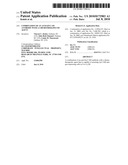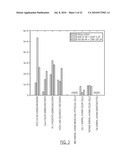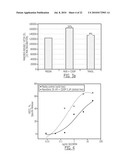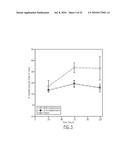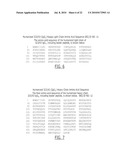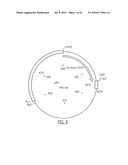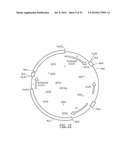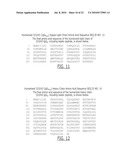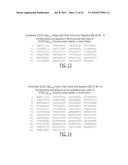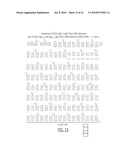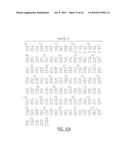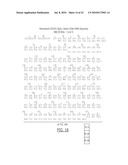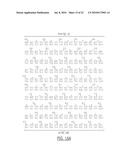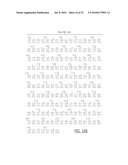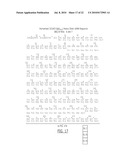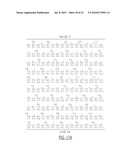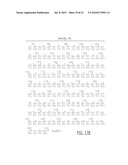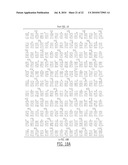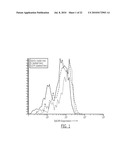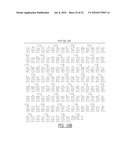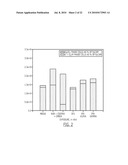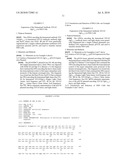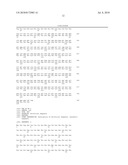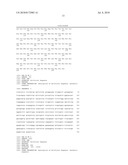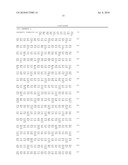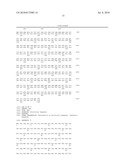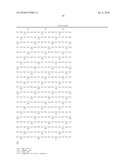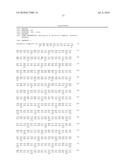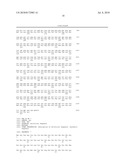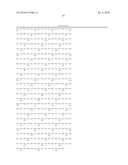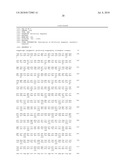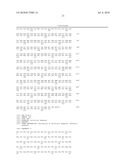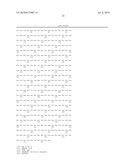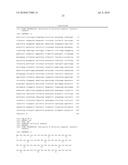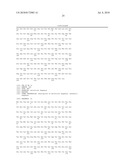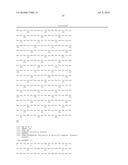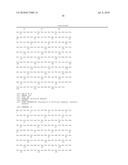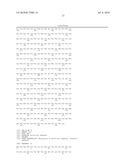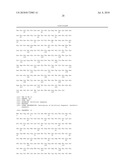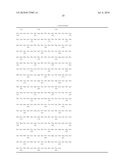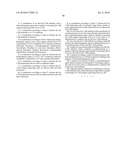Patent application title: Combination of an Anti-Ep-CAM Antibody with a Chemotherapeutic Agent
Inventors:
Vincent C. Knick (Durham, NC, US)
Julie Beth Stimmel (Durham, NC, US)
Linda M. Thurmond (Durham, NC, US)
IPC8 Class: AA61K39395FI
USPC Class:
4241331
Class name: Drug, bio-affecting and body treating compositions immunoglobulin, antiserum, antibody, or antibody fragment, except conjugate or complex of the same with nonimmunoglobulin material structurally-modified antibody, immunoglobulin, or fragment thereof (e.g., chimeric, humanized, cdr-grafted, mutated, etc.)
Publication date: 2010-07-08
Patent application number: 20100172903
Claims:
1. A combination of an anti-Ep-CAM antibody with a chemotherapeutic agent
that is capable of arresting Ep-CAM antigen expressing cells in S or
G2/M.
2. A combination according to claim 1 wherein the Ep-CAM antibody is a 17.1A antibody.
3. A combination according to claim 2 wherein the Ep-CAM antibody is Panorex.
4. A combination according to claim 1 wherein the chemotherapeutic agent is one or more agents selected from UFT, Capecitabine, CPT-II, Oxaliplatin, 5FU continuous infusion, Paclitaxel, Docetaxel, Cyclophosphamide, Methotrexate, Doxorubicin, Navelbine (iv and oral), Epirubicin, Mitoxantrone, Raloxifen, Cisplatin, Mitomycin, Carboplatinum, Gemcitabine, Etoposide and Topotecan.
5. A combination according to claim 4, wherein the chemotherapeutic agent is CPT-II, 5FU (continuous infusion), Oxaliplatin, Capecitibine, UFT and Tomudex (Raloxifen).
6. A combination according to claim 1 wherein the Ep-CAM expressing cells are cells of epithelial origin.
7. A combination according to claim 1 wherein the Ep-CAM antigen expressing cells are tumour cells and their metastases.
8. A combination according to claim 7, wherein the Ep-CAM expressing tumour cells are adenocarcinoma cells and their metastases.
9. A combination according to claim 7, wherein the Ep-CAM expressing cells are prostate, lung, breast, gastric or colon originating cells or other tumours known to express the Ep-CAM antigen.
10. Use of an anti-Ep-CAM antibody in the manufacture of a medicament for use in anti-cancer therapy characterized in that a chemotherapeutic agent which is capable of arresting Ep-CAM antigen expressing cells in S or in G2/M is co-administered to a patient with an anti-Ep-CAM antibody.
11. Use of an anti-Ep-CAM antibody according to claim 10 wherein the chemotherapeutic agent is administered prior to or simultaneously with the anti-Ep-CAM antibody.
12. A method of increasing antibody binding of an anti-Ep-CAM antibody which comprises co-administering to a patient a chemotherapeutic agent capable of arresting cells in S or in G2/M with an Ep-CAM antibody.
13. A method according to claim 11 which increases antibody binding between 2 to 10 fold compared to binding in the absence of said chemotherapeutic agent.
14. A method of treatment wherein a chemotherapeutic agent which is capable of arresting Ep-CAM antigen expressing cells in S or in G2/M is co-administered to a patient with an anti-Ep-CAM antibody.
15. A pharmaceutical composition comprising an anti-Ep-CAM antibody with a chemotherapeutic agent that is capable of arresting EP-CAM antigen expressing cells in G2/M.
Description:
[0001]This application is a continuation of U.S. patent application Ser.
No. 11/034,655 filed Jan. 13, 2005, now granted as U.S. Pat. No.
7,648,703, which is a continuation of U.S. application Ser. No.
10/031,355 filed Jan. 18, 2002, now abandoned, which was filed pursuant
to 35 U.S.C. §371 as a United States National Phase application of
International Application No. PCT/EP99/05271 filed Jul. 23, 1999.
[0002]This present invention relates to the combination of antibodies that specifically bind to the EP-CAM antigen with chemotherapeutic agents that affect cell growth by blocking progression of the cell cycle in G2/M and their use in therapy of cancers which express the antigen.
[0003]The conventional therapeutic approaches to cancer include surgery, radiotherapy and chemotherapy in various combinations; however, response rates have not improved significantly in the last 20 years. The major limitation of chemotherapy and radiotherapy is the non-selective targeting of both normal and tumour cells that results in toxic side effects. In the search for less toxic and more specific treatment alternatives, various types of immunotherapy have been investigated. Among these modalities, strategies based on monoclonal antibodies have been applied to a broad spectrum of malignancies (Riethmuller et al. Curr Opin Immun 1992, 4, 647-655 and Riethmuller et al. Curr Opin Immunol 1993, 5, 732-739). The utility of monoclonal antibodies is based upon their clonal antigen specificity, i.e. molecular recognition of specific epitopes which may comprise an antigen and to bind to these antigens with high affinity. Monoclonal antibodies can bind to antigens expressed uniquely or preferentially on the surface of malignant cells, and hence can be used to specifically target and destroy tumour cells. Antibodies may be constructed as delivery vehicles for drugs or DNA, or as conjugates with radionuclides. Binding of naked antibody to target cells may also activate innate antitumour immune functions such as antibody-dependent cell-mediated cytotoxicity (ADCC) and complement-mediated cytotoxicity (CMC), either of which may result in lysis or phagocytosis of the targeted cell. Both ADCC and CMC are antibody-dose-related immune functions and it is therefore desirable to get as much antibody bound to target cells as possible.
[0004]One way of achieving this objective is to increase the level of expression of the relevant antigen which may effectively increase antibody functions such as, for example, ADCC of the target cells by virtue of getting more antibody bound to the cells (Fogler et al. Cancer Research 48: 6303-6308 (1988)).
[0005]One antigen of importance in cancer therapy is the Ep-CAM antigen (human pan-carcinoma antigen). This antigen is a transmembrane glycoprotein which has been reported to function as a cell adhesion molecule (Litvinow et al. J. Cell Biology 125: 437-446, 1994) and is also known as the 17-1A antigen, 40 kD antigen, EGP40, GA733-2, KSA and ESA but may be known by other names or descriptions in the literature as well. It is expressed on the baso-lateral surface of a majority of simple cuboidal or columnar, pseudo stratified columnar and transitional epithelia and at generally higher levels in tumour cells. Epithelial cells are known to be the most important cell type in the development of human malignancies. Thus more than 90% of all malignant tumours are carcinomas, and therefore of epithelial origin (Acta Anatomica; 156 (3); 217-226 (1996)). Although the Ep-CAM antigen is expressed on most tumour cells of epithelial origin there are examples of cells of epithelal origin that do not express Ep-CAM such as adult epithelial tissues, epidermal adult keratinocytes, gastric parietal cells, thymic cortical epithelium, myoepithelial cells and hepatocytes. The phenotype of a malignant cell plays an important role in the efficacy of monoclonal antibodies. While tumour specific antigens have proven to be elusive, differences in expression of the antigens between normal cells and tumour cells have provided a means to target antibodies to tumours. It would be clinically advantageous to improve on these differences by enhancement of antigen homogeneity and density of expression on tumour cells.
[0006]Interferons are well-known to alter cell phenotypes by increasing expression of tumour antigens as well as many normal antigens, e.g. Class I HLA. For example, human recombinant interferon-α and interferon-γ can increase the expression of human tumour antigens TAG-72 and CEA (Greiner et al. Cancer Res 44:3208-3214 (1984)). Interferon exposure induced a more homogeneous CEA-positive tumour cell population which shed more CEA from the cells surface, which was confirmed by in vivo studies with human carcinoma xenografts in athymic mice. Treatment with interferon-γ enhanced TAG-72 and CEA expression on ovarian or gastrointestinal tumour cells in patients' malignant ascites (Greiner et al. J Clin Oncol 10:735-746 (1992)). The effects of interferons on cells are myriad and range from direct cytotoxicity to immunopotentiation to antiproliferative activity. None of the effects of interferons on antigen expression have been directly ascribed to interference with cell cycle progression.
[0007]Briefly, cell cycle progression refers to the sequence of events between one mitotic division and another in a cell. A quiescent resting phase (G0) is followed by a growth phase (G1), then by a DNA synthesis phase (S). A second growth phase of cell enlargement (G2) and DNA replication (M phase) is followed by division of the cell into two progeny cells. Any interference with the cell machinery may inhibit all cycle progression at any phase of the cell cycle. For example, specific chemotherapeutic agents may block progression in either G2 or M or in both G2 and M (G2/M). In other words exposure to certain drugs e.g. chemotherapeutic agents will for example, arrest individual cells in G2 and/or M until eventually most, or all of the cells in a population become arrested in G2 and/or M (G2/M). In HeLa cells, for example, the G1, S, G2 and M phase take 8.2, 6.2, 4.6 and 0.6 hours, respectively. The period between mitoses is called interphase. Cells may have different doubling times, depending on their developmental stage or tissue type. The variation in doubling times is usually a function of the time spent in G1 (A Dictionary of Genetics, 5th edition, R C King and W D Stansfield, Oxford University Press, 1997).
[0008]While a few proteins have been identified as produced solely at certain phases of the cell cycle, and therefore can serve as markers of cell cycle status, most others are produced across the cell cycle but at higher or lower levels at certain points. Variation of antigen density across the cell cycle is typical for the sarcoma antigens p102 and p200 (Song S, Anticancer Research 16(3A): 1171-5 (1996)), the leukaemia/lymphoma-associated antigen JD118 (Czuczman et al. Cancer Immunology, Immunotherapy 36(6):387-96 (1993)), and the gastric tumour antigen PC1 (Wei et al., J of Oncology 9(3): 179-82 (1987)). A few tumour antigens have been reported to be cell-cycle independent, e.g. liver metastases 3H4 (Wulf et al., J. Cancer Research and Clinical Oncology 122(8): 476-82 (1996)) and small cell lung cancer antigens (Fargion et al., Cancer Research 46: 2633-2638 (1986)).
[0009]Surprisingly, it has been found that pre-treatment with a drug, for example a chemotherapeutic agent known to block cell cycle progression at S and/or G2/M results in a significant increase in the density of the Ep-CAM antigen population and thus in greater targeting of anti-Ep-CAM antibodies to Ep-CAM expressing tumours. In lytic antibodies this translates into an increased susceptibility to antibody-dependent cytolysis. This perturbation of tumour cell phenotype has a significant impact on the biological effectiveness of therapeutic antibodies, and provides synergistic benefit to standard chemotherapeutic regimens. Furthermore, this increase in Ep-CAM antigen expression appears to be tumour specific. In other words, pre-treatment with chemotherapeutic agents that block the cell cycle at S and/or G2/M does not seem to affect Ep-CAM antigen expression in non-tumour cells.
[0010]Accordingly, the present invention provides a combination of an Ep-CAM antibody and a chemotherapeutic agent that is capable of arresting Ep-CAM antigen expressing cells in S or G2/M, preferably in G2/M.
[0011]Examples of anti-Ep-CAM antibodies are ING1 (Colcher et al., Proc. Natl. Acad. Sci. USA, 78 (5), 3199 to 3203 (1981) and Laio et al, Human Antibody Hybridomas 1(2), 66-76 (1990)); 17-1A e.g. Panorex (Herlyn et al, Proc. Natl. Acad. Sci. USA 76: 1438-1452 (1979) and Herlyn et al, Hybridoma 1985; 5 (suppl. 1) S3 to S10); and NR-LU-10 (Okabe et al, Cancer Research, 44, 5273 to 5278 (1984)).
[0012]Panorex (Adjuqual®) is a 17.1A mouse monoclonal antibody. It is marketed by Glaxo Wellcome in Germany for the post-operative adjuvant therapy of colorectal cancer.
[0013]An example of an anti-Ep-CAM antibody is one with the variable light chain cDNA sequence as set out in FIG. 15 and the heavy chain cDNA sequence as set out in FIG. 16. (known as humanised 323/A3/IgG1). Two further preferred examples of anti-Ep-CAM antibodies are those with the variable light chain cDNA sequence as set out in FIG. 15 and heavy chain cDNA sequences as set out in FIG. 17 or 18 respectively (known as humanised 323/A3 IgG4 and IgG2cys respectively).
[0014]A preferred example of an anti-Ep-CAM antibody is 17.1A, most preferably Panorex.
[0015]Specific anti-Ep-CAM antibodies can be given on their own or in combination with other anti-Ep-CAM antibodies. Examples of such anti-Ep-CAM antibody combinations are an anti-Ep-CAM antibody with the variable light chain cDNA sequence as set out in FIG. 15 and the heavy chain cDNA sequence as set out in FIG. 16 in combination with ING1. Thus throughout the specification reference to an anti-Ep-CAM antibody includes antibody combinations of various anti-Ep-CAM antibodies, preferably non-competing anti-Ep-CAM antibodies targeting different epitopes on the same Ep-CAM antigen. Examples of chemotherapeutic agents which are capable of arresting Ep-CAM antigen expressing cells in G2/M are vinorelbine, cisplatin, mytomycin, paclitaxel, carboplatin, oxaliplatin and CPT-II (camptothecin).
[0016]Vinorelbine tartrate is a semisynthetic vinca alkaloid with the chemical name 3',4'-didehydro-4'-deoxy-C'-norvincaleukoblastine [R--(R*,R*)-2,3-dihydroxybutanedioate (1:2)(salt)]. Vinorelbine tartrate is used in combination with other chemotherapy agents such as cisplatin or as a single agent in the treatment of various solid tumours particularly non-small cell lung, advanced breast, and hormone refractory prostate cancers. The brand name Navelbine® is used in North America and Europe. Navelbine® is administered intravenously as a single-agent or in combination therapy typically at doses of 20-30 mg/m2 on a weekly basis. An oral formulation of vinorelbine is in clinical development.
[0017]Cisplatin has the chemical name cis-diamminedichloroplatinum. Cisplatin is used in the treatment of metastatic testicular tumours as a combination therapy, as single and combination therapy in metastatic ovarian tumours, as well as a single agent in advanced bladder cancer. Cisplatin is manufactured by Bristol-Myers Squibb under the brand names of Platinol® and Platinol-AQ®. Cisplatin is also used in the following types of cancer, typically in combination therapy: non-small cell and small cell lung cancers, head and neck, endometrial, cervical, and non-Hodgkin's lymphoma. Cisplatin is typically administered intravenously in doses ranging from 15-150 mg/m2 once every 3 to 4 weeks, or daily for 5 days repeated every 3 or 4 weeks. However, higher and more frequent doses are occasionally administered and the route of administration could be different than intravenous, such as intra-arterial or intraperitoneal.
[0018]Carboplatin has the chemical name platinum, diammine [1,1-cyclobutane-dicarboxylato(2)-0,0']-(SP-4-2). Carboplatin is usually administered in combination with other cytotoxics such as paclitaxel and etoposide. It is used in the treatment of advanced ovarian cancer, non-small cell lung cancer as well as in many of the same types of cancer as cisplatin is used. The brand name of carboplatin manufactured by Bristol-Myers Squibb is Paraplatin®. Carboplatin is typically administered intravenously at 300-400 mg/m2, or to a target area under the drug concentration versus time curve (AUC) of 4-6 mg/ml-min using the patient's estimated glomerular filtration rate (GFR). Higher doses up to around 1600 mg/m2 divided over several, usually five, days may also be administered.
[0019]Paclitaxel has the chemical name 5β, 20 epoxy-1,2α,4,7β,10β,13α-hexahydroxytax-1'-en-9-one 4,10-diacetate 2-benzoate 13-ester with (2R, 3S)--N-benzoyl-3-phenylisoserine. Paclitaxel is manufactured by Bristol-Myers Squibb as Taxol®. It is used to treat a variety of carcinomas including ovarian, breast, non-small cell lung, head and neck. Typical doses include 135-175 mg/m2 as either a 3 or 24 hour intravenous infusion given every 3 or 4 weeks. Higher doses up to around 300 mg/m2 have also been administered.
[0020]Besides the active ingredient, the drug products provided by manufacturers typically contain a diluent such as sterile water, dextrose 5% in water or 0.9% sodium chloride in water with additional excipients such as Cremophor vehicle added to make for example, paclitaxel soluble.
[0021]More detailed information on treatment regimes, dosages and compositions etc can be obtained from standard reference books such as: Martindale, The Extra Pharmacopoeia, 31st edition, edited by JEF Reynolds, London, Royal Pharmaceutical Society, 1996 and the Physicians Desk reference, 49th Edition, 1995, Medical Economics Data Production Company, Montvale.
[0022]Other chemotherapeutic agents that may cause cells to accumulate in G2/M include anthracyclines e.g. doxorubicin and aclarubicin; carmustine (BCNU), camptothecin, 9-nitro-camptothecin, cyclophosphamide and its derivatives, docetaxel, etoposide, Razoxane (ICRF-187), alkyllyso-phospholipids e.g. ilmofosine; methotrexate, MST-16, taxanes, vinblastine, vincristine and teniposide (VM-26) (again see Martindale, The Extra Pharmacopoeia, 31st edition, edited by JEF Reynolds, London, Royal Pharmaceutical Society, 1996) and flavonoids e.g. apigenin and genistein (see The Merck Index, 12th edition, Merck Research Laboratories, Merck and Co Inc, 1996). In addition, adozelesin (a class of pyrazole compounds) (Cancer Research 1992, Oct. 15; 52 (2): 5687 to 5692)), Bistratene A (Mutation Research 1996, Mar. 1; 367 (3): 169 to 175), cycloxazoline (Cancer Chemotherapy & Pharmacology 1994; 33(5): 399 to 409), imidazoarcridinone, melephan (Experimental Cell Biology 1986; 54 (3): 138 to 148 and International Journal of Cancer 1995, Jul. 17; 62 (2): 170 to 175), merbarone (Environmental & Molecular Mutagenesis 1997; 29 (1): 16 to 27 and Cancer Research 1995, Apr. 1; 55 (7): 1509 to 1516) and oracin (FEBS Letters 1997, Jan 2; 400 (1): 127 to 130) are also believed to cause cells to accumulate in G2/M generally all topo II inhibitors, e.g. to potecan (abpi, 1998-1999), all vinca derivatives and all DNA damaging agents including radiation are also believed to arrest cells in G2/M.
[0023]Moreover, 5FU has been reported to arrest cells in G2/M (Oncology Research 1994; 6(7):303-309) and it is therefore believed that 5FU and compounds similar to 5FU such as UFT, methotrexate, capecitabine and Gemcitabine will increase Ep-Cam expression in some tissues. Similarly, tomudex (Raloxifen) which is known to arrest cells in the S phase is believed to increase Ep-Cam expression.
[0024]The term "chemotherapeutic agent" throughout the specification is therefore not limited to cytotoxic therapy, but also encompasses cytostatic therapy and any other drugs capable of stopping cells in G2/M. It should be further noted that radiotherapy is capable of arresting cells in G2/M and that throughout the specification the term chemotherapeutic can therefore be substituted with "radiotherapy".
[0025]Throughout the specification reference to a chemotherapeutic agent includes combinations of one or more specific chemotherapeutic agents which arrest Ep-CAM expressing tumour cells in G2/M. Examples of typical combinations are vinorelbine with cisplatin and paclitaxel with carboplatin; oxaliplatin with 5FU; cyclophosphamide with methotrexate and 5FU; cyclophosphamide with doxorubicin and 5FU.
[0026]While it is possible for the chemotherapeutic agent to be administered alone it is preferable to present it as a pharmaceutical composition comprising an active ingredient, as defined above, together with an acceptable carrier therefor. Each carrier must be "acceptable" in the sense of being compatible with the other ingredients of the composition and not injurious to the recipient.
[0027]Preferred combinations of an Ep-Cam antibody and a chemotherapeutic agent(s) that are capable of arresting Ep-CAM antigen expressing cells in S or G2/M are: Panorex in combination with any of the following chemotherapeutic agents: UFT, Capecitabine, CPT-II, Oxaliplatin, 5FU, 5FU continuous infusion, Paclitaxel, Docetaxel, Cyclophosphamide, Methotrexate, Doxorubicin, Navelbine (iv and oral), Epirubicin, Mitoxantrone, Raloxifen, Cisplatin, Mitomycin, Carboplatinum, Gemcitabine, Etoposide and Topotecan.
[0028]Particularly preferred combinations are Panorex with CPT-II, 5FU (continuous infusion), Oxaliplatin, Capecitibine, UFT and Tomudex (Raloxifen).
[0029]These Panorex combinations are useful in the treatment of cancer, particularly in the treatment of colorectal cancer, breast cancer, gastric cancer, prostate cancer and non-small-cell lung cancer.
[0030]Specifically, the following combinations are particularly preferred for colorectal cancer: Panorex in combination with: UFT (optionally with Leucovorin); Capecitabine; Oxaliplatin (optionally with 5FU); CPT-II, 5FU (optionally with Eniluracil or Levamisole or Leucovorin); 5FU protacted continuous infusion; and Mitomycin.
[0031]Preferred combinations for the treatment of breast cancer are: Panorex in combination with Paclitaxel; Docetaxel; Cyclophosphamide (optionally with 5FU and either Methotrexate or Doxorubicin); Navelbine (iv and/or oral); Doxorubicine; Epirubicin; Mitoxantrone; and Raloxifin.
[0032]Preferred combinations for the treatment of gastric cancer are: Panorex in combination with Cisplatin; 5FU; Mitomycin; and Carboplatinum.
[0033]A preferred combination for the treatment of prostatic cancer is: Panorex in combination with Mitoxantrone.
[0034]Preferred combinations for the treatment of non-small-cell lung cancer are: Panorex in combination with: Navelbine; Cisplatin; Carboplatin; Paclitaxel; Docetaxel; Gemcitabine; Topotecan; and Etoposide.
[0035]Information regarding dosing of Panorex and the above chemotherapeutic agents given in combination with Panorex can be found in standard reference books such as ABPI, Compendium of Data Sheets and Summaries of Product Characteristics, Datapharm Publications Limited, 1998-1999.
[0036]The compositions include those suitable for oral, rectal, nasal, topical (including buccal and sublingual), vaginal, parenteral (including subcutaneous, intramuscular, intravenous and intradermal) or transdermal administration. The compositions may conveniently be presented in unit dosage form and may be prepared by any methods well known in the art of pharmacy. Such methods include the step of bringing into association the active ingredient with the carrier which constitutes one or more accessory ingredients. In general, the compositions are prepared by uniformly and intimately bringing into association
the active ingredient with liquid carriers or finely divided solid carriers or both, and then if necessary shaping the product.
[0037]Compositions of the chemotherapeutic agent suitable for oral administration may be presented as discrete units such as capsules, cachets or tablets each containing a predetermined amount of the active ingredient; as a powder or granules; as a solution or suspension in an aqueous or non-aqueous liquid; or as an oil-in-water liquid emulsion or a water-in-oil liquid emulsion. The active ingredient may also be presented as a bolus, electuary or paste.
[0038]A tablet may be made by compression or moulding, optionally with one or more accessory ingredients. Compressed tablets may be prepared by compressing in a suitable machine the active ingredient in a free-flowing form such as a powder or granules, optionally mixed with a binder (e.g. povidone, gelatin, hydroxypropylmethyl cellulose), lubricants, inert diluent, preservative, disintegrant (eg. sodium starch glycollate, cross-linked povidone, cross-linked sodium carboxymethyl cellulose) surface-active or dispersing agent. Moulded tablets may be made by moulding in a suitable machine a mixture of the powdered compound moistened with an inert liquid diluent. The tablets may optionally be coated or scored and may be formulated so as to provide slow or controlled release of the active ingredient therein using, for example, hydroxypropylmethyl cellulose in varying proportions to provide the desired release profile. Tablets may optionally be provided with an enteric coating to provide release in parts of the gut other than the stomach.
[0039]Compositions suitable for oral use as described above may also include buffering agents designed to neutralise stomach acidity. Such buffers may be chosen from a variety of organic or inorganic agents such as weak acids or bases admixed with their conjugated salts.
[0040]Composition suitable for topical administration in the mouth include lozenges comprising the active ingredient in a flavoured basis, usually sucrose and acacia or tragacanth; pastilles comprising the active ingredient in an inert basis such as gelatine and glycerin, or sucrose and acacia and mouthwashes comprising the active ingredient in a suitable carrier.
[0041]Compositions for rectal administration may be presented as a suppository with suitable base comprising for example cocoa butter or a salicylate.
[0042]Compositions suitable for vaginal administration may be presented as pessaries, tampons, creams, gels, pastes, foams or spray formulations containing in addition to the active ingredient such carriers as are known in the art to be appropriate.
[0043]Compositions suitable for parenteral administration include aqueous and non-aqueous isotonic sterile injection solutions which may contain anti-oxidants, buffers, bacteriostats and solutes which render the compositions isotonic with the blood of the intended recipient; and aqueous and non-aqueous sterile suspensions which may include suspending agents and thickening agents, such as liposomes or other microparticulate systems which are designed to target the compounds to blood components or one or more organs. The compositions may be presented in unit-dose or multi-dose sealed containers, for example, ampoules and vials, and may be stored in a freeze-dried(lyophilized) condition requiring only the addition of sterile liquid carrier, for example water for injections, immediately prior to use. Extemporaneous injection solutions and suspensions may be prepared from sterile powders, granules and tablets of the kind previously described.
[0044]Compositions suitable for transdermal administration may be presented as discrete patches adapted to remain in intimate contact with the epidermis of the recipient for a prolonged period of time. Such patches suitably contain the active ingredient as an optionally buffered, aqueous solution of, for example, 0.1 0.2M concentration with respect to said compound. As one particular possibility, the active ingredient may be delivered from the patch by iontophoresis as generally described in Pharmaceutical Research, 3 (6), 318 (1986).
[0045]It should be understood that in addition to the ingredients particularly mentioned above the compositions in question, for example, those suitable for oral administration may include such further agents as sweeteners, thickeners and flavouring agents.
[0046]The dosage range of the chemotherapeutic agent to be co-administered with the antibody may typically be between about 1 to 1000 mg/m2 (based on patient body surface area) or about 2-30 mg/kg (based on patient body weight), depending on the chemotherapeutic agent(s) used. Thus, for example, vinorelbine (navelbine) would typically be administered at a dosage of about 20 to 30 mg/m2, cisplatin at about 15 to 100 mg/m2 carboplatin at about 300 to 600 mg/m2 and paclitaxel at about 100 to 300 mg/m2, preferably around 135 to 175 mg/m2. Another way of expressing dosage is by their AUC value. For example carboplatin would typically be administered at a dose calculated as AUC=4 to 6 mg/ml-min. Generally, the doses of chemotherapeutic agents are lower when given in combination with another chemotherapeutic agent and/or antibody than if given on their own as the single chemotherapeutic agent. The doses of chemotherapeutic agents that will be co-administered with anti Ep-CAM antibody(ies) will likely be the standard doses for the type of carcinoma treated or lower doses. In general the highest tolerated doses of the chemotherapeutic agents are administered either alone or in combination.
[0047]The anti-Ep-CAM antibodies of the present invention preferably have the structure of a natural antibody or a fragment thereof. Antibodies typically comprise two heavy chains linked together by disulphide bonds and two light chains. Each light chain is linked to a respective heavy chain by disulphide bonds. Each heavy chain has at one end a variable domain followed by a number of constant domains. Each light chain has a variable domain at one end and a constant domain at its other end. The light chain variable domain is aligned with the variable domain of the heavy chain. The light chain constant domain is aligned with the first constant domain of the heavy chain. The constant domains in the light and heavy chains are not involved directly in binding the antibody to antigen.
[0048]The variable domains of each pair of light and heavy chains form the antigen binding site. The domains on the light and heavy chains have the same general structure and each domain comprises a framework of four regions, whose sequences are relatively conserved, connected by three complementarity determining regions (CDRs). The four framework regions largely adopt a beta-sheet conformation and the CDRs form loops connecting, and in some cases forming part of the beta-sheet structure. The CDRs are held in close proximity by the framework regions and with the CDRs from the other domain, contribute to the formation of the antigen binding site, which in the case of the present invention is the formation of an anti-Ep-CAM binding site. CDRs and framework regions of antibodies may be determined by reference to Kabat et al ("Sequences of proteins of immunological interest" US Dept. of Health and Human Services, US Government Printing Office, 1987).
[0049]The preparation of an antibody in which the CDRs are derived from a different species than the framework of the antibody's variable domains is disclosed in EP-A-0239400. The CDR's may be derived from a rodent or primate monoclonal antibody. The framework of the variable domains and the constant domains of such altered antibodies are usually derived from a human antibody. Such a humanised antibody should not elicit as great an immune response when administered to a human compared to the immune response mounted by a human against a wholly foreign antibody such as one derived from a rodent.
[0050]The antibody preferably has the structure of a natural antibody or a fragment thereof. Throughout the specification reference to antibody therefore comprises not only a complete antibody but also fragments such as a (Fab') 2 fragment, a Fab fragment, a light chain dimer or a heavy chain dimer. The antibody may be an IgG such as IgG1, IgG2, IgG3 or IgG4; or IgM, IgA, IgE or IgD or a modified variant thereof, including those that may be conjugated to other molecules such as radionuclides, enzymes etc. Typically, the constant region is selected according to the functionality required. Normally an IgG1 will demonstrate lytic ability through binding to complement and will mediate ADCC (antibody dependent cell cytotoxicity). An IgG4 antibody will be preferred if a non-cytotoxic antibody is required. Antibodies according to the present invention also include bispecific antibodies such as, for example, the 17-1A antibody disclosed in Mack et al, The Journal of Immunology, 1997, 158: 3965-3970. Antibodies of the present invention may be murine, chimaeric or humanised with the preferred antibody being humanised antibody.
[0051]There are four general steps to humanise a monoclonal antibody. These are: [0052](1) determining the nucleotide and predicted amino acid sequence of the starting antibody light and heavy variable domains; [0053](2) designing the humanised antibody, i.e. deciding which antibody framework region to use during the humanising process; [0054](3) the actual humanising methodologies/techniques; and [0055](4) the transfection and expression of the humanised antibody.
[0056]More specifically,
Step 1: Determining the Nucleotide and Predicted Amino Acid Sequence of the Antibody Light and Heavy Chain Variable Domains
[0057]To humanise an antibody only the amino acid sequence of the antibody's heavy and light chain variable domains needs to be known. The sequence of the constant domains is irrelevant because these do not contribute to the reshaping strategy. The simplest method of determining an antibody variable domain amino acid sequence is from cloned cDNA encoding the heavy and light variable domain.
[0058]There are two general methods for cloning a given antibody's heavy and light chain variable domain cDNAs: (1) via a conventional cDNA library, or (2) via the polymerase chain reaction (PCR). Both of these methods are widely known. Given the nucleotide sequence of the cDNAs, it is a simple matter to translate this information into the predicted amino acid sequence of the antibody variable domains.
Step 2: Designing the Humanised Antibody
[0059]There are several factors to consider in deciding which human antibody sequence to use during the humanisation. The humanisation of light and heavy chains are considered independently of one another, but the reasoning is basically similar for each.
[0060]This selection process is based on the following rationale: a given antibody's antigen specificity and affinity is primarily determined by the amino acid sequence of the variable region CDRs. Variable domain framework residues have little or no direct contribution. The primary function of the framework regions is to hold the CDRs in their proper spatial orientation to recognise the antigen. Thus the substitution of rodent CDRs into a human variable domain framework is most likely to result in retention of their correct spatial orientation if the human variable domain framework is highly homologous to the rodent variable domain from which they originated. A human variable domain should preferably be chosen therefore that is highly homologous to the rodent variable domain(s).
[0061]A suitable human antibody variable domain sequence can be selected as follows: [0062]1. Using a computer program, search all available protein (and DNA) databases for those human antibody variable domain sequences that are most homologous to the rodent antibody variable domains. The output of a suitable program is a list of sequences most homologous to the rodent antibody, the percent homology to each sequence, and an alignment of each sequence to the rodent sequence. This is done independently for both the heavy and light chain variable domain sequences. The above analyses are more easily accomplished if only human immunoglobulin sequences are included. [0063]2. List the human antibody variable domain sequences and compare for homology. Primarily the comparison is performed on lengths of CDRs, except CDR 3 of the heavy chain which is quite variable. Human heavy chains and Kappa and Lambda light chains are divided into subgroups; Heavy chain 3 subgroups, Kappa chain 4 subgroups, Lambda chain 6 subgroups. The CDR sizes within each subgroup are similar but vary between subgroups. It is usually possible to match a rodent antibody CDR to one of the human subgroups as a first approximation of homology. Antibodies bearing CDRs of similar length are then compared for amino acid sequence homology, especially within the CDRs, but also in the surrounding framework regions. The human variable domain which is most homologous is chosen as the framework for humanisation.
Step 3: The Actual Humanising Methodologies/Techniques
[0064]An antibody may be humanised by grafting the desired CDRs onto a human framework according to EP-A-0239400. (see also P. T. Jones et al, Nature 321:522 (1986); L. Reichman et al, Nature 332:323 (1988); Verhoeyen M. et al, Science 239:1534 (1988) and J. Ellis et al, The Journal of Immunology, 155:925-937 (1995)). A DNA sequence encoding the desired reshaped antibody can therefore be made beginning with the human DNA whose CDRs it is wished to reshape. The rodent variable domain amino acid sequence containing the desired CDRs is compared to that of the chosen human antibody variable domain sequence. The residues in the human variable domain are marked that need to be changed to the corresponding residue in the rodent to make the human variable region incorporate the rodent CDRs. There may also be residues that need substituting in, adding to or deleting from the human sequence.
[0065]Oligonucleotides are synthesised that can be used to mutagenise the human variable domain framework to contain the desired residues. Those oligonucleotides can be of any convenient size. One is normally only limited in length by the capabilities of the particular synthesiser one has available. The method of oligonucleotide-directed in vitro mutagenesis is well known.
[0066]Alternatively humanisation may be achieved using the recombinant polymerase chain reaction (PCR) methodology of WO92/07075. Using this methodology, a CDR may be spliced between the framework regions of a human antibody.
[0067]In general, the technique of WO92/07075 can be performed using a template comprising two human framework regions, AB and CD and between them, the CDR which is to be replaced by a donor CDR. Primers A and B are used to amplify the framework region AB, and primers C and D used to amplify the framework region CD. However, the primers B and C each also contain, at their 5' ends, an additional sequence corresponding to all or at least part of the donor CDR sequence. Primers B and C overlap by a length sufficient to permit annealing of their 5' ends to each other under conditions which allow a PCR to be performed. Thus, the amplified regions AB and CD may undergo gene splicing by overlap extension to produce the humanised product in a single reaction.
Step 4: The Transfection and Expression of the Reshaped Antibody
[0068]Following the mutagenesis reactions to reshape the antibody, the mutagenised DNAs can be linked to an appropriate DNA encoding a light or heavy chain constant region, cloned into an expression vector, and transfected into host cells, preferably mammalian cells. These steps can be carried out in routine fashion. A reshaped antibody may therefore be prepared by a process comprising: [0069](a) preparing a first replicable expression vector including a suitable promoter operably linked to a DNA sequence which encodes at least a variable domain of an Ig heavy or light chain, the variable domain comprising framework regions from a human antibody and the CDRs required for the humanised antibody of the invention. [0070](b) preparing a second replicable expression vector including a suitable promoter operably linked to a DNA sequence which encodes at least the variable domain of a complementary Ig light or heavy chain respectively; [0071](c) transforming a cell line with the first or both prepared vectors; and [0072]d) culturing said transformed cell line to produce said altered antibody.
[0073]Preferably the DNA sequence in step (a) encodes both the variable domain and the or each constant domain of the human antibody chain. The humanised antibody can be recovered and purified. The cell line which is transformed to produce the altered antibody may be Chinese Hamster Ovary (CHO) cell line or an immortalised mammalian cell line, which is advantageously of lymphoid origin, such as a myeloma, hybridoma, trioma or quadroma cell line. The cell line may also comprise a normal lymphoid cell, such as a B-cell, which has been immortalised by transformation with a virus, such as the Epstein-Barr virus. Most preferably, the immortalised cell line is a myeloma cell line or a derivative thereof. The expression system of choice is the glutamine synthetase expression system described in WO87/00462 (see also P. E. Stephens et al, Nucleic Acid Res. 17:7110 (1989) and C. R. Bebbington et al, Bio/Technology 10:169 (1992)).
[0074]Although the cell line used to produce the humanised antibody is preferably a mammalian cell line, any other suitable cell line, such as a bacterial cell line or a yeast cell line, may alternatively be used. For single antibody chains, it is envisaged that E. coli-derived bacterial strains could be used. The antibody obtained is checked for functionality. If functionality is lost, it is necessary to return to step (2) and alter the framework of the antibody.
[0075]Once expressed, the whole antibodies, their dimers, individual light and heavy chains, or other immunoglobulin forms of the present invention can be purified according to standard procedures of the art, including ammonium sulfate precipitation, affinity columns, column chromatography, gel electrophoresis and the like (see generally Scopes, R, Protein Purification, Springer-Verlag, N.Y. (1982)). Substantially pure immunoglobulins of at least about 90 to 95% homogeneity are preferred and 98 to 99% or more homogeneity most preferred, for pharmaceutical uses. Once purified, partially or to homogeneity as desired, an antibody may then be used therapeutically.
[0076]Antibodies are typically provided as a pharmaceutical composition comprising a pharmaceutically acceptable carrier or diluent and, as active ingredient, an antibody according to the invention. The antibody and pharmaceutical compositions thereof are particularly useful for parenteral administration i.e. subcutaneously, intramuscularly or intravenously.
[0077]The compositions for parenteral administration will commonly comprise a solution of the antibody or a cocktail thereof dissolved in an acceptable carrier, preferably an aqueous carrier. A variety of aqueous carriers can be used, eg. sterile water for injection, 0.9% sodium chloride in water, 5% dextrose in water and Lactated Ringers solution. These solutions are sterile and generally free of particulate matter. These compositions may be sterilised by conventional, well known sterilisation techniques. The compositions may contain pharmaceutically acceptable auxiliary substances as required to approximate physiological conditions such as pH adjusting and buffering agents, toxicity adjustment agents and the like, for example sodium acetate, sodium chloride, potassium chloride, calcium chloride, sodium lactate, etc. The concentration of antibody in these formulations can vary widely, for example from less than about 0.5%, usually at or at least about 1% to as much as 15 or 20% by weight and will be selected primarily based on fluid volumes, viscosities, etc. in accordance with particular mode of administration selected.
[0078]Thus, a typical pharmaceutical composition for intramuscular injection could be made to contain 1 ml sterile buffered water, and 50 mg of antibody. A typical composition for intravenous infusion could be made up to contain 250 ml of sterile Ringers solution and 150 mg of antibody. Actual methods for preparing parenterally administrable compositions will be known or apparent to those skilled in the art, particularly, those trained in the preparation of parenteral products and are described in more detail in, for example, Remmington's Pharmaceutical Science, 15th Ed., Mack Publishing Company, Easton, Pa. (1990).
[0079]The antibodies of this invention can be lyophilised for storage and reconstituted in a suitable carrier prior to use. This technique has been shown to be effective with conventional immunoglobulins. Any suitable lyophilisation and reconstitution techniques can be employed. It will be appreciated by those skilled in the art that lyophilization and reconstitution can lead to varying degrees of antibody activity loss (eg. with conventional immune globulins, IgM antibodies tend to have greater activity loss than IgG antibodies) and that use levels may have to be adjusted to compensate.
[0080]The dosage range of the antibody in accordance with the invention is about 0.5 to 1000 mg/m2, preferably about 0.5 to 250 mg/m2, more preferably, between 0.5 and 100 mg/m2 and 0.5 and 50 mg/m2 and most preferably between 5 and 25 mg/m2 such as for example, 15 mg/m2.
[0081]Similarly, expressed in mg per dose, the dosages of the antibody may be about 1 to 2000 mg per dose, preferably about 1 to 500 mg per dose, more preferably between 1 to 200 mg per dose and between 1 to 100 mg per dose and most preferably between 10 and 50 mg per dose such as, for example 30 mg per dose.
[0082]Single or multiple administrations of the compositions can be carried out with dose levels and pattern being selected by the treating physician. In any event, the pharmaceutical formulations should provide a quantity of the antibody(ies) sufficient to effectively treat the patient.
[0083]Typically, the chemotherapeutic agent and antibody will be presented as separate pharmaceutical compositions for co-administration, but they may also be formulated as a single pharmaceutical formulation. In this way both the antibody and the chemotherapeutic agent are presented to the patient within one and the same composition.
[0084]One or more distinct chemotherapeutic agents and one or more distinct anti-Ep-CAM antibodies may be co-administered in all aspects of the present invention. Thus reference to a chemotherapeutic agent comprises one or more distinct chemotherapeutic agent(s). If there is more than one chemotherapeutic agent, these may be administered either individually each on its own and/or together as a chemotherapeutic agent cocktail. Similarly, reference to antibody comprises one or more distinct anti-Ep-CAM antibody(ies). If there is more than one antibody, these may again be administered either individually each on its own and/or together as a cocktail. Additionally, the chemotherapeutic agent(s) are typically administered separately from the antibody(ies) but they may also be administered together as a chemotherapeutic agent(s)/antibody(ies) cocktail.
[0085]Co-administration of the chemotherapeutic agent/radiotherapy with the antibody comprehends administration substantially simultaneously of both the chemotherapeutic agent/radiotherapy and the antibody. Essentially, the rational behind co-administration is to allow sufficient exposure of Ep-CAM expressing tumour cells to a chemotherapeutic agent/radiotherapy known to block cell cycle progression at G2/M to achieve the desired increase in Ep-CAM antigen density prior to exposure of the same tumour cells to an anti-Ep-CAM antibody thereby achieving greater targeting of anti-Ep-CAM antibodies to Ep-CAM expressing tumours. Co-administration therefore comprises any mode of administering a chemotherapeutic agent/radiotherapy in conjunction with an anti-Ep-CAM antibody that will achieve this result.
[0086]Throughout the specification the term "combination of an anti-Ep-CAM antibody with a chemotherapeutic agent" refers to one wherein the chemotherapeutic agent/radiotherapy and the anti-Ep-CAM antibody have been co-administered.
[0087]Preferably the chemotherapeutic agent is administered simultaneously with the antibody or more preferably before the antibody. Thus the chemotherapeutic agent may be administered on the same day as the antibody, either together or within hours of each other but may also be administered up to about two months beforehand, typically, about one or two weeks beforehand and more typically less than a week beforehand, say one to three days beforehand.
[0088]Additionally, co-administration also includes administering more than one dose of antibody within several weeks after one or more doses of chemotherapeutic agent, in other words the chemotherapeutic agent need not be re-administered again with every subsequent administration of the antibody, but may be administered just once or intermittently during the course of antibody treatment. Co-administration also comprises administration of the chemotherapeutic agent up to 3 weeks after the antibody, preferably within a week and more preferably within a few days such as one to five days.
[0089]The antibody may be administered several times daily. Similarly the chemotherapeutic agent may be infused continuously over several hours or even days.
[0090]The present invention also provides a method of treating mammalian patients, preferably humans, afflicted with cancer which comprises co-administering a chemotherapeutic agent which is capable of arresting Ep-CAM antigen expressing cells in G2/M in combination with an anti-Ep-CAM antibody. Preferably, the chemotherapeutic agent is given simultaneously and more preferably prior to administration of the antibody.
[0091]The cancers which may be treated particularly effectively with this combination therapy are primary or metastatic cancers of any histologic or histogenetic origin that express the Ep-CAM antigen. This includes, for example, prostate cancers, lung cancers, breast cancers, colon cancers, pancreatic cancers and ovarian cancers.
[0092]Dosing schedules for the treatment method of the present invention can be adjusted to account for the patient characteristics, disease state, characteristics of the chemotherapeutic agent and characteristics of the anti-Ep-CAM antibody. The goal of dosing schedules under this invention will be to administer anti-Ep-CAM antibody in a manner that will expose the Ep-CAM expressing tumour cells to the anti-Ep-CAM antibody at a time when antigen expression is likely to be increased due to exposure to chemotherapy which is known to block cell cycle progression at G2/M. Additionally, as much as possible a dosing schedule convenient for the patient must be maintained.
[0093]Preferred dosing schedules for administration of the anti-Ep-CAM antibody and chemotherapy include: administering the anti-Ep-CAM antibody once every one or two weeks, preferably once every three or four weeks or a combination thereof for as long as necessary. The chemotherapeutic agent is given according to the established regimen for that agent or a regimen which will allow exposure of Ep-CAM expressing tumour cells to be arrested in G2/M. Preferred dosing schedules vary with the chemotherapy agent and disease state but include, for example, once weekly, once every three or four weeks, or daily for several (e.g. 3-5) days repeated every three or four weeks for as long as necessary. Dosing of the anti-Ep-CAM antibody may take place on the same day or different days as indicated for the chemotherapeutic agent. Adjustment of the dosing schedule or strength of dose to prevent or decrease toxicity or side effects may take place with either the anti-Ep-CAM antibody or the chemotherapy agent.
[0094]For example, the preferred dosing schedule for co-administration of vinorelbine and cisplatin in combination with humanised 323/A3 (IgG1) is administration of humanised 323/A3 (IgG1) at a dose of 30 mg/m2 once a week for as long as necessary but typically for a period of 3 to 4 weeks, followed by a 30 mg/m2 dose every other week thereafter for as long as necessary. Vinorelbine is administered at a dose 25 mg/m2 on day 1,8,15 and 22. Cisplatin is given only once at a dose of 100 mg/m2 on day 1. Thereafter the vinorelbine/cisplatin regime is repeated every 28 days for as long as necessary. Preferably, vinorelbine, cisplatin and humanised 323/A3 (IgG1) are administered at the same time on day one over a period of about 2 to 3 hours.
[0095]Another example of a preferred dosing schedule is the administration of paclitaxel/carboplatin in combination with humanised 323/A3 (IgG1), wherein 323/A3 (IgG1) is administered as for the vinorelbine/cisplatin example above and paclitaxel and carboplatin are given at a dose of 225 mg/m2 and AUC=6.0 respectively, on day 1, with a repeat dosage every 28 days thereafter for as long as necessary. Again, paclitaxel, carboplatin and humanised 323/A3 (IgG1) are preferably administered together on day 1 over a period of about 2 to 3 hours.
[0096]Other preferred dosage schedules which comprise the combination of 323/A3 (IgG1) with any of navelbine, cisplatin or taxol on their own would comprise similar dosages and administration schedules, using just one anticancer agent instead of two.
[0097]When the preferred anti-Ep-CAM antibody is Panorex, the dosage of antibody is between 10 to 500 mg per dose, preferably 100 mg per dose.
[0098]A further aspect of the present invention is a method of increasing antibody binding of anti-Ep-CAM antibodies to Ep-CAM expressing cells by co-administering to a patient a chemotherapeutic agent capable of arresting cells in G2/M together with said anti-Ep-CAM antibody.
[0099]By co-administering a chemotherapeutic agent according to the present invention together with an Ep-CAM antibody, it is possible to increase antibody binding by about 2 to 10 fold, preferably by more than 4 fold, more preferably by more than 6 fold and most preferably by more than 8 fold.
FIGURES
[0100]FIG. 1.
[0101]Ep-CAM is expressed across the cell cycle, but at higher density and greater homogeneity on cells in S (dotted line) and in G2/M (dashed line) phases than in G0/G1 cells (solid line). This pattern of expression has been documented in a number of other human colon, prostrate, and lung tumour cell lines.
[0102]FIG. 2.
[0103]Cell cycle arrest is a prominent feature of adenocarcinoma cells exposed in vitro to Navelbine (NVB; 30 nM) plus Cisplatin (CDDP; 5 μM), or Taxol (TAX; 80 nM) plus Carboplatin (CPBDA; 100 μM), compared to media alone, 5-Fluorouracil (5FU), interferon-alpha (IFN-alpha; 100 U/ml), or interferon-gamma (IFN-gamma; 100 U/ml). The area of each bar is divided to indicate the percentage of cells in G0/G1 and in S+G2/M phases; the height of each bar indicates the average number of Ep-CAM molecules per cell within the population. Cells in S phase and in G2/M phase express higher levels of Ep-CAM (FIG. 1), and the agents which blocked cell cycle progression had overall increased Ep-CAM expression
[0104]FIG. 3.
[0105]The expression of Ep-CAM antigen was quantified on a variety of adenocarcinoma cell lines as well as primary cultures of normal human cells. Cultured cells were exposed sequentially to media, or to 30 nM Navelbine followed by 5 μM Cisplatin (NVB+CDDP), or to 80 nM Taxol followed by 100 μM Carboplatin (TAX+CPBDA). The 4 adenocarcinoma cells expressed higher antigen levels subsequent to exposure to cycle-specific drug combinations, whereas the 4 normal cells did not show any increase in antigen expression, which remained undetectable in 2 of the normal cell populations.
[0106]FIG. 3a.
[0107]The binding of Panorex, a related murine monoclonal antibody with specificity for the Ep-CAM antigen, was evaluated after a 15 minute incubation with HT29 adenocarcinoma cells which had been cultured with Navelbine plus Cisplatin or with Taxol as previously described. A significant increase (34%) in antibody binding was seen on the cells treated with Navelbine plus Cisplatin; 82% of these cells were arrested in S or G2/M cycle phase compared to 21% of the control cells. (A smaller increase (8%) in antibody binding was seen for cells treated with Taxol, but in this experiment only 57% of the cells were cycle-arrested) as is shown in FIG. 3a.
[0108]FIG. 4.
[0109]The ability of human peripheral blood ADCC effector cells to lyse tumour target cells incubated with humanized 323/A3 (IgG1) (a humanized monoclonal antibody having specificity for the Ep-CAM antigen and capable of interacting with Fc receptors on human effector cells) in vitro was improved when the target cells had been pre-treated with NAVELBINE (30 nM) plus Cisplatin (5 μM).
[0110]FIG. 5.
[0111]Treatment of human tumour xenograft-bearing mice with a cell-cycle-specific cytotoxic agent promoted improved localization of antibody specific for Ep-CAM to the tumours.
[0112]FIG. 6.
[0113]Humanised 323/A3 (IgG1) Kappa Light Chain Amino Acid Sequence SEQ ID NO:11
[0114]FIG. 7.
[0115]Humanised 323/A3 (IgG1) Heavy Chain Amino Acid Sequence SEQ ID NO:12
[0116]FIG. 8.
[0117]Vector Map of pEE6
[0118]FIG. 9.
[0119]Vector Map of pEE12
[0120]FIG. 10.
[0121]Vector Map of pEE18
[0122]FIG. 11
[0123]Humanised 323/A3 (IgG4cys) Kappa Light Chain Amino Acid Sequence SEQ ID NO: 13
[0124]FIG. 12
[0125]Humanised 323/A3 (IgG4cys) variant Heavy Chain Amino Acid Sequence SEQ ID NO: 14
[0126]FIG. 13
[0127]Humanised 323/A3 (IgG2cys) Kappa Light Chain Amino Acid Sequence SEQ ID NO: 15
[0128]FIG. 14
[0129]Humanised 323/A3 (IgG2 cys) Heavy Chain Amino Acid Sequence SEQ ID NO:16
[0130]FIG. 15
[0131]Humanised 323/A3 (IgG1) light chain cDNA Sequence (also 323/A3 (IgG4cys and IgG2cys light chain cDNA sequence) and corresponding amino acid sequence, SEQ ID NO:1, SEQ ID NO:2 and SEQ ID NO:3
[0132]FIG. 16
[0133]Humanised 323/A3 (IgG1) Heavy chain cDNA Sequence and corresponding amino acid sequence, SEQ ID NO:4 and SEQ ID NO:5
[0134]FIG. 17
[0135]Humanised 323/A3 (IgG4) heavy chain cDNA Sequence and corresponding amino acid sequence, SEQ ID NO:6 and SEQ ID NO:7
[0136]FIG. 18
[0137]Humanised 323/A3 (IgG2cys) heavy chain cDNA Sequence and corresponding amino acid sequence SEQ ID NO:8, SEQ ID NO: 9 and SEQ ID NO:10
[0138]The following examples illustrate the invention.
EXAMPLE 1
Ep-CAM Antigen Expression Varied by Phase Across the Cell Cycle on PC-3 Prostatic Adenocarcinoma Cells
[0139]Populations of PC-3 prostatic adenocarcinoma cells were evaluated for distribution in G0/G1, S, and G2/M phases of the cell cycle as well as Ep-CAM expression. Cells were gently trypsinized and mechanically detached from the culture flasks and resuspended in calcium- and magnesium-free phosphate-buffered saline containing bovine serum albumin and NaN3. Exactly 2×105 cells were stained with FITC-323/A3 murine IgG antibody or FITC-murine IgG (control). Cells were fixed with cold paraformaldehyde, then permeabilized for DNA staining with Tween-20. Cellular DNA was stained with propidium iodide and RNase A. Listmode data were acquired on a FACScan flow cytometer (Becton Dickinson Immunocytometry Systems) equipped with a 488 nm laser using Cell Fit software. Cell cycle analysis was done using SOBR modelling (where possible, otherwise manual estimations were employed) on Cell Fit. Ep-CAM antigen expression as detected by 323/A3 binding was evaluated separately using histogram analysis in Win List (Verity Software House).
[0140]FIG. 1 shows that Ep-CAM is expressed across the cell cycle, but at higher density and greater homogeneity on cells in S (dotted line) and in G2/M (dashed line) phases than in G0/G1 cells (solid line). This pattern of expression has been documented in a number of other human colon, prostate, and lung tumor cell lines.
EXAMPLE 2
Increased Expression of Ep-CAM Antigen on Adenocarcinoma Cells was Associated with Arrest of Cell Cycle Progression and Accumulation of Cells in S and G2/M Phases
[0141]Adenocarcinoma cell lines were exposed to the various drugs or combinations of drugs as indicated in FIG. 2. Subconfluent cells were exposed to Navelbine or Taxol for up to 24 hours, then washed and exposed to Cisplatin or Carboplatin, respectively, overnight. Cells were exposed to 5FU for 24 hours, and for 2-5 days to the interferons. Cells were washed and cultured for another 2-5 days prior to analysis for antigen expression and cell cycle status as described in Example 1. Antigen expression was quantified by comparison of the binding of fluorescein-conjugated 323/A3 to cultured cells with binding to calibrated microbead standards.
[0142]Cell cycle analysis demonstrated that only 6.3% of the media control cells were in S and G2/M phases combined, compared to 39.4% of NVB+CDDP and 82.6% of TAX+CPBDA cells, both combinations of which caused significant increases in Ep-CAM antigen expression (as demonstrated in FIG. 2). Antigen expression was not significantly increased in cells exposed to 5FU, IFN-α, or IFN-γ, which had only 7.9%, 12%, and 11.5%, respectively, of cells in S+G2/M phase. Thus, only the drugs which caused accumulation of cells in S or G2/M phases were able to cause a significant increase in Ep-CAM antigen expression.
EXAMPLE 2a
[0143]The binding of Panorex, a related murine monoclonal antibody with specificity for the Ep-CAM antigen, was evaluated after a 15 minute incubation with HT29 adenocarcinoma cells which had been cultured with Navelbine plus Cisplatin or with Taxol as previously described. A significant increase (34%) in antibody binding was seen on the cells treated with Navelbine plus Cisplatin; 82% of these cells were arrested in S or G2/M cycle phase compared to 21% of the control cells. (A smaller increase (8%) in antibody binding was seen for cells treated with Taxol, but in this experiment only 57% of the cells were cycle-arrested) as is shown in FIG. 3a.
EXAMPLE 3
Increased Ep-CAM Antigen Expression was Observed on Tumour Cells but not Normal Cells Exposed to Cytotoxic Drugs In Vitro
[0144]The expression of Ep-CAM antigen was quantified on a variety of adenocarcinoma cell lines as well as primary cultures of normal human cells. Cultured subconfluent cells were exposed sequentially to media, or to 30 nM Navelbine followed by 5 μM Cisplatin (NVB+CDDP), or to 80 nM Taxol followed by 100 μM Carboplatin (TAX+CPBDA). Cells were washed with media and cultured for another 2-5 days prior to analysis for antigen expression as described in Examples 1 and 2.
[0145]FIG. 3 clearly shows that the 4 adenocarcinoma cells expressed higher antigen levels subsequent to exposure to cycle-specific drug combinations, whereas the 4 normal cells did not show any increase in antigen expression, which remained undetectable in 2 of the normal cell populations
EXAMPLE 4
Cells Exposed to NAVELBINE Plus Cisplatin were Better Targets for Human ADCC Activity than Control Cells
[0146]Adenocarcinoma cells were exposed to drugs as described in Examples 1 and 2 above, and then harvested and seeded into 96-well plates for use as target cells in a 51Cr-release cytotoxicity assay. Target cells were cultured overnight with 51Cr, and then washed. Human peripheral blood mononuclear cells which had been allowed to adhere overnight were added at a 50:1 effector:target ratio, and the ADCC cultures were incubated for 6 hours. Supernatants were collected and counted for radioactivity, and the percentage specific release was calculated. (see FIG. 4).
[0147]FIG. 4 clearly shows that PC-3 prostatic adenocarcinoma cells are better targets for human ADCC activity after exposure to Navelbine/Cisplatin compared to controls which have not been exposed to these chemotherapeutic agents. This effect may be due directly to increased antigen expression and thereby increased antibody binding, decreased modulation of the Ep-CAM antigen, increased fragility of the target cells, or a combination of the above.
EXAMPLE 5
Antibody Targeting to Ep-CAM-Positive Tumours was Significantly Improved by Pre-Treatment of the Mice with NAVELBINE
[0148]Human colon adenocarcinoma (HT-29) tumours were initiated by subcutaneous implantation into female CD-1 nude mice (Charles River). When the tumours reached 200-300 mg, animals were divided into groups of five. Navelbine was injected intravenously at a dosage of 28 mg/kg on days 1 and 5. A control group was dosed with 5-fluorouracil (5-FU) intraperitoneally at 20 mg/kg on days 1 and 5. On day 6, humanised 323/A3 IgG4cys-TMT (a humanized monoclonal antibody chelator conjugate with specificity for the Ep-CAM antigen) was labelled with lutetium-177 and injected intravenously via the lateral tail vein. Each mouse received 4.1 μg protein/2.09 μCi lutetium-177/0.2 ml injection. Blood, spleen, liver, lung, kidney, femur and tumour were harvested on days 1, 3 and 5 post-antibody for direct gamma counting (see FIG. 5 for results).
[0149]FIG. 5 shows that pre-treatment with Navelbine increases antibody targeting to Ep-CAM positive tumours whilst pre-treatment with 5-FU does not.
EXAMPLE 6
Expression of the Humanized Antibody 323/A3 (IgG1) Variant in NSO Cells
1. Purpose/Summary
[0150]The cDNAs encoding the humanized 323/A3 antibody light and heavy chains (see FIGS. 15 and 16 respectively) were genetically engineered into a single Celltech glutamine synthetase (GS) expression plasmid, pEE18 (see FIG. 10), and used to transfect murine NSO cells.
2. Materials and Methods
[0151]2.1 Materials [0152]NSO cells were obtained from Celltech Biologics plc, Slough, SL1 4EN, Berkshire, UK. The expression plasmids pEE6HCMV and pEE12 (see FIGS. 8 and 9) were obtained from Celltech Biologics plc, Slough. [0153]2.2 The pEE6hmcv plasmid (see FIG. 8) encoding full length humanised heavy chain DNA was digested with Bam HI and Bgl II to liberate the 3.2 kb fragment that contained the DNA encoding the heavy chain under the transcriptional control of the major immediate early promoter of the human cytomegalovirus. This fragment was cloned into the Bam HI site of pEE12 (FIG. 9) that contained the DNA encoding the humanised light chain. (See FIG. 6 for humanised 323/A3 (IgG1) Kappa light chain amino acid sequence and FIG. 7 for the humanised 323/A3(IgG1) Heavy chain amino acid sequence. See FIG. 10 for schematic representation of the pEE18 plasmid encoding 323/A3 (IgG1) heavy and light chains. [0154]2.2.2 Transfection and Selection of NSO Cells [0155]2.2.2.1 Tissue Culture [0156]All single cell culture activities were performed in isolated rooms that contained a single laminar flow hood and single incubator dedicated solely to the use of NSO cells in the production of stable cell lines secreting humanised 323/A3(IgG1). No other NSO cells lines, human cell lines or virus transformed cell lines were used within this environment. [0157]A vial of NSO cells was revived and grown in 1:1:1 medium composed of DMEM:RPMI-1640:Sigma PFHM (1:1:1) to a cell density between 0.5 and 1×106 mL. For electroporation, the cells were harvested by centrifugation and washed once with PBS. pEE18 plasmid DNA encoding 323/A3 (IgG1) was digested with Sal I, heat inactivated at 65° C. for 15 minutes, precipitated with ethanol and air-dried. The dried DNA pellet was resuspended in PBS to a concentration of 0.5 μg/mL and 100 μL aliquoted into a 2 mm electroporation cuvette (BTX). Washed NSO cells were resuspended at 1.2×107/ml and 400 μL added to the cuvette to give a final density of 106 mL in a final volume of 0.5 mL. Electroporation was at 300 V for 1 msec in a BTX 8209 GenePulser followed by incubation on ice for 5-10 minutes. The electroporation mixture was resuspended at 105 cells/mL with 1:1:1 medium and distributed over 96-well plates at 50 μL/well. The following day, wells were fed with 150 μL GS medium (Gln-free IMDM, 1=X GS and nucleoside supplement, 5% DFBS) to begin the GS selection process such that all wells had a final concentration of 3% DFBS. [0158]2.2.2.2 Specific Production Rate (SPR) [0159]Selected cell lines grown in GS media (3% DFBS) were seeded at a density of 0.2×106 cells/mL in T-25 flasks (Costar) that contained 5 mL of GS media (3% DFBS). Cells were incubated overnight at 37° C. for 24 hours after which an aliquot of each culture supernatant was removed. The supernatants were used in the human IgG ELISA assay to determine the concentration of secreted humanised 323/A3(IgG1). The SPR value was derived by multiplying the concentration of 323/A3 (IgG1) antibody in the supernatant times the volume (5.0) and is expressed as μg/106 cells/24 hours. [0160]2.2.2.3 Cryopreservation of Cells [0161]Selected cell lines were routinely harvested when cell density was greater than 0.2×106 cells/mL. An appropriate volume of cells was removed and subjected to centrifugation at 1,000×g for 5 minutes at 22° C. The cell pellet was gently resuspended to 1-4×106 cells/mL with ice-cold freezing media consisting of 20% (v/v) FBS/10-% (v/v) DMSO/GS Media (sterile filtered). Each 1.0 mL of the cell suspension was aliquoted into a 1.8 ml cryopreservation vial (NUNC) and gradually frozen overnight in a Cryo 1° C. Freezing Container (Nalgene) that had been placed in a -70° C. freezer. The vials were then removed from the container and stored in the vapour phase of a liquid nitrogen freezer. [0162]Twenty vials of each cell line, including a low humanised 323/A3(IgG1) producer were frozen down as described above and stored initially in the vapour phase of an MVE Cryogenics XLC440 liquid nitrogen freezer. The cells were subsequently transferred and stored in the vapour phase of an MVE Cryogenics XLC500 liquid nitrogen freezer.
EXAMPLE 7
Expression of the Humanized Antibody 323/A3(IgG4cys) in NSO Cells
1. Purpose Summary
[0163]The cDNAs encoding the humanized antibody 323/A3(IgG4cys) (a humanised 323/A3 antibody) antibody light and heavy chains (see FIGS. 15 and 17 were genetically engineered into a single Celltech glutamine synthetase (GS) expression plasmid, pEE18, and used to transfect murine NSO cells.
2. Materials and Methods
[0164]2.1 Materials (as for Example 6 above)2.2 Creation of humanised 323/A3 (IgG4 cys pEE18 Expression Plasmid [0165]The pEE6HMCV plasmid (see FIG. 8) encoding full length humanized heavy chain DNA was digested with BAM HI and Bgl II to liberate a 3.2 kb fragment that contained the DNA encoding the heavy chain under the transcriptional control of the major immediate early promoter of the human cytomeglovirus. This fragment was cloned into the Bam HI site of pEE12 that contained the DNA encoding the humanized light chain (See FIG. 11 for humanised 323/A3(IgG4) Kappa Light Chain Amino Acid Sequence and FIG. 12 for the 323/A3 IgG4cys variant Heavy Chain Amino Acid Sequence). See FIG. 10 for schematic representation of the pEE18 plasmid encoding 323/A3 heavy and light chains.2.2.2 Transfection and Selection of NSO Cells: see Example 6 above.
EXAMPLE 8
Expression of the Humanized Antibody 323/A3(IgG2cys) in NSO Cells
1. Purpose/Summary
[0165] [0166]The cDNAs encoding the humanized 323/A3(IgG2cys) antibody heavy and light chains were genetically engineered into a single Celltech glutamine synthethase (GS) expression plamid, pEE18, and used to transfect murine NSO cells.
2. Materials and Methods
[0167]2.1 Materials as for Examples 6 and 7 above2.2 Creation of 323/A3 (IgG2cys) pEE18 Expression for Plasmid [0168]The pEEE6 hcmv plasmid encoding full length humanized heavy chain DNA was digested with Bam HI and Bgl II to liberate 3.2 kb fragment that contained the DNA encoding the heavy chain under the transcriptional control of the major immediate early promoter of the human cytomegalovirus. This fragment was cloned into the Bam II site of pEE12 that contained the DNA encoding the humanized light chain (See FIG. 13 for 323/A3(IgG2cys) Kappa Light Chain Amino Acid Sequence and FIG. 14 for the 323/A3(IgG2cys) Heavy Chain Amino Acid Sequence). See FIG. 10 for schematic representation of the pEE18 plasmid encoding 323/A3 (IgG2cys) heavy and light chains.2.2.2 Transfection and Selection of NSO Cells--See Examples 6 and 7 above.
Sequence CWU
1
161740DNAArtificial SequenceCDS(24)..(740)Description of Artificial
Sequence Synthetic sequence 1cgtaagcttc acaggacctc acc atg gga tgg
agc tgt atc atc ctc ttc ttg 53 Met Gly Trp
Ser Cys Ile Ile Leu Phe Leu 1 5
10gta gca aca gct aca ggt gtc cac tcc gat att gtg atg act
cag tct 101Val Ala Thr Ala Thr Gly Val His Ser Asp Ile Val Met Thr
Gln Ser 15 20 25cca ctc
tcc ctg ccc gtc acc cct gga gag ccg gcc tcc atc tcc tgt 149Pro Leu
Ser Leu Pro Val Thr Pro Gly Glu Pro Ala Ser Ile Ser Cys 30
35 40agg tct agt aag aat ctc ctg cat agt
aat ggc atc act tat ttg tat 197Arg Ser Ser Lys Asn Leu Leu His Ser
Asn Gly Ile Thr Tyr Leu Tyr 45 50
55tgg tac ctg cag aag cca ggg cag tct cca cag ctc ctg atc tat cag
245Trp Tyr Leu Gln Lys Pro Gly Gln Ser Pro Gln Leu Leu Ile Tyr Gln 60
65 70atg tcc aac ctt gcc tca ggg gtc cct
gac agg ttc agt agc agt gga 293Met Ser Asn Leu Ala Ser Gly Val Pro
Asp Arg Phe Ser Ser Ser Gly75 80 85
90tca ggc aca gat ttt aca ctg aaa atc agc aga gtg gag gct
gag gat 341Ser Gly Thr Asp Phe Thr Leu Lys Ile Ser Arg Val Glu Ala
Glu Asp 95 100 105gtt ggg
gtt tat tac tgt gct caa aat cta gag att cct cgg acg ttc 389Val Gly
Val Tyr Tyr Cys Ala Gln Asn Leu Glu Ile Pro Arg Thr Phe 110
115 120ggc caa ggg acc aag gtg gag atc aaa
cgt acg gtg gct gca cca tct 437Gly Gln Gly Thr Lys Val Glu Ile Lys
Arg Thr Val Ala Ala Pro Ser 125 130
135gtc ttc atc ttc ccg cca tct gat gag cag ttg aaa tct gga act gcc
485Val Phe Ile Phe Pro Pro Ser Asp Glu Gln Leu Lys Ser Gly Thr Ala 140
145 150tct gtt gtg tgc ctg ctg aat aac
ttc tat ccc aga gag gcc aaa gta 533Ser Val Val Cys Leu Leu Asn Asn
Phe Tyr Pro Arg Glu Ala Lys Val155 160
165 170cag tgg aag gtg gat aac gcc ctc caa tcg ggt aac
tcc cag gag agt 581Gln Trp Lys Val Asp Asn Ala Leu Gln Ser Gly Asn
Ser Gln Glu Ser 175 180
185gtc aca gag cag gac agc aag gac agc acc tac agc ctc agc agc acc
629Val Thr Glu Gln Asp Ser Lys Asp Ser Thr Tyr Ser Leu Ser Ser Thr
190 195 200ctg acg ctg agc aaa gca
gac tac gag aaa cac aaa gtc tac gcc tgc 677Leu Thr Leu Ser Lys Ala
Asp Tyr Glu Lys His Lys Val Tyr Ala Cys 205 210
215gaa gtc acc cat cag ggc ctg agc tcg ccc gtc aca aag agc
ttc aac 725Glu Val Thr His Gln Gly Leu Ser Ser Pro Val Thr Lys Ser
Phe Asn 220 225 230agg gga gag tgt tag
740Arg Gly Glu
Cys2352238PRTArtificial SequenceDescription of Artificial Sequence
Synthetic sequence 2Met Gly Trp Ser Cys Ile Ile Leu Phe Leu Val Ala
Thr Ala Thr Gly1 5 10
15Val His Ser Asp Ile Val Met Thr Gln Ser Pro Leu Ser Leu Pro Val
20 25 30Thr Pro Gly Glu Pro Ala Ser
Ile Ser Cys Arg Ser Ser Lys Asn Leu 35 40
45Leu His Ser Asn Gly Ile Thr Tyr Leu Tyr Trp Tyr Leu Gln Lys
Pro 50 55 60Gly Gln Ser Pro Gln Leu
Leu Ile Tyr Gln Met Ser Asn Leu Ala Ser65 70
75 80Gly Val Pro Asp Arg Phe Ser Ser Ser Gly Ser
Gly Thr Asp Phe Thr 85 90
95Leu Lys Ile Ser Arg Val Glu Ala Glu Asp Val Gly Val Tyr Tyr Cys
100 105 110Ala Gln Asn Leu Glu Ile
Pro Arg Thr Phe Gly Gln Gly Thr Lys Val 115 120
125Glu Ile Lys Arg Thr Val Ala Ala Pro Ser Val Phe Ile Phe
Pro Pro 130 135 140Ser Asp Glu Gln Leu
Lys Ser Gly Thr Ala Ser Val Val Cys Leu Leu145 150
155 160Asn Asn Phe Tyr Pro Arg Glu Ala Lys Val
Gln Trp Lys Val Asp Asn 165 170
175Ala Leu Gln Ser Gly Asn Ser Gln Glu Ser Val Thr Glu Gln Asp Ser
180 185 190Lys Asp Ser Thr Tyr
Ser Leu Ser Ser Thr Leu Thr Leu Ser Lys Ala 195
200 205Asp Tyr Glu Lys His Lys Val Tyr Ala Cys Glu Val
Thr His Gln Gly 210 215 220Leu Ser Ser
Pro Val Thr Lys Ser Phe Asn Arg Gly Glu Cys225 230
2353740DNAArtificial SequenceDescription of Artificial Sequence
Synthetic sequence 3ctaacactct cccctgttga agctctttgt gacgggcgag
ctcaggccct gatgggtgac 60ttcgcaggcg tagactttgt gtttctcgta gtctgctttg
ctcagcgtca gggtgctgct 120gaggctgtag gtgctgtcct tgctgtcctg ctctgtgaca
ctctcctggg agttacccga 180ttggagggcg ttatccacct tccactgtac tttggcctct
ctgggataga agttattcag 240caggcacaca acagaggcag ttccagattt caactgctca
tcagatggcg ggaagatgaa 300gacagatggt gcagccaccg tacgtttgat ctccaccttg
gtcccttggc cgaacgtccg 360aggaatctct agattttgag cacagtaata aaccccaaca
tcctcagcct ccactctgct 420gattttcagt gtaaaatctg tgcctgatcc actgctactg
aacctgtcag ggacccctga 480ggcaaggttg gacatctgat agatcaggag ctgtggagac
tgccctggct tctgcaggta 540ccaatacaaa taagtgatgc cattactatg caggagattc
ttactagacc tacaggagat 600ggaggccggc tctccagggg tgacgggcag ggagagtgga
gactgagtca tcacaatatc 660ggagtggaca cctgtagctg ttgctaccaa gaagaggatg
atacagctcc atcccatggt 720gaggtcctgt gaagcttacg
74041418DNAArtificial
SequenceCDS(24)..(1418)Description of Artificial Sequence Synthetic
sequence 4cgtaagcttc acagatcctc acc atg gga tgg agc tgt atc atc ctc ttt
ctg 53 Met Gly Trp Ser Cys Ile Ile Leu Phe
Leu 1 5 10gtg
gca aca gct aca ggt gtc cac tcc cag gta cag cta gtg caa tca 101Val
Ala Thr Ala Thr Gly Val His Ser Gln Val Gln Leu Val Gln Ser
15 20 25ggg cct gaa gtg aag aag cct
ggg gcc tca gtg aaa gtt tcc tgc aag 149Gly Pro Glu Val Lys Lys Pro
Gly Ala Ser Val Lys Val Ser Cys Lys 30 35
40gct tct ggc tac acc ttc acc aac tat gga atg aac tgg gta
agg cag 197Ala Ser Gly Tyr Thr Phe Thr Asn Tyr Gly Met Asn Trp Val
Arg Gln 45 50 55gcg cct gga cag
ggg ctt gag tgg atg ggg tgg ata aac acc tac act 245Ala Pro Gly Gln
Gly Leu Glu Trp Met Gly Trp Ile Asn Thr Tyr Thr 60 65
70gga gag cca aca tat ggt gaa gat ttc aag gga cgg ttt
gca ttc tct 293Gly Glu Pro Thr Tyr Gly Glu Asp Phe Lys Gly Arg Phe
Ala Phe Ser75 80 85
90cta gac aca tcc gcc agc aca gcc tat atg gag ctc agc tcg ctg aga
341Leu Asp Thr Ser Ala Ser Thr Ala Tyr Met Glu Leu Ser Ser Leu Arg
95 100 105tcc gag gac act gca gtc
tat ttc tgt gcg aga ttt ggt aac tac gta 389Ser Glu Asp Thr Ala Val
Tyr Phe Cys Ala Arg Phe Gly Asn Tyr Val 110
115 120gac tac tgg ggt caa gga tca cta gtc act gtc tcc
tca gcc tcc acc 437Asp Tyr Trp Gly Gln Gly Ser Leu Val Thr Val Ser
Ser Ala Ser Thr 125 130 135aag ggc
cca tcg gtc ttc ccc ctg gca ccc tcc tcc aag agc acc tct 485Lys Gly
Pro Ser Val Phe Pro Leu Ala Pro Ser Ser Lys Ser Thr Ser 140
145 150ggg ggc aca gcg gcc ctg ggc tgc ctg gtc aag
gac tac ttc ccc gaa 533Gly Gly Thr Ala Ala Leu Gly Cys Leu Val Lys
Asp Tyr Phe Pro Glu155 160 165
170ccg gtg acg gtg tcg tgg aac tca ggc gcc ctg acc agc ggc gtg cac
581Pro Val Thr Val Ser Trp Asn Ser Gly Ala Leu Thr Ser Gly Val His
175 180 185acc ttc ccg gct gtc
cta cag tcc tca gga ctc tac tcc ctc agc agc 629Thr Phe Pro Ala Val
Leu Gln Ser Ser Gly Leu Tyr Ser Leu Ser Ser 190
195 200gtg gtg acc gtg ccc tcc agc agc ttg ggc acc cag
acc tac atc tgc 677Val Val Thr Val Pro Ser Ser Ser Leu Gly Thr Gln
Thr Tyr Ile Cys 205 210 215aac gtg
aat cac aag ccc agc aac acc aag gtg gac aag aaa gtt gag 725Asn Val
Asn His Lys Pro Ser Asn Thr Lys Val Asp Lys Lys Val Glu 220
225 230ccc aaa tct tgt gac aaa act cac aca tgc cca
ccg tgc cca gca cct 773Pro Lys Ser Cys Asp Lys Thr His Thr Cys Pro
Pro Cys Pro Ala Pro235 240 245
250gaa ctc ctg ggg gga ccg tca gtc ttc ctc ttc ccc cca aaa ccc aag
821Glu Leu Leu Gly Gly Pro Ser Val Phe Leu Phe Pro Pro Lys Pro Lys
255 260 265gac acc ctc atg atc
tcc cgg acc cct gag gtc aca tgc gtg gtg gtg 869Asp Thr Leu Met Ile
Ser Arg Thr Pro Glu Val Thr Cys Val Val Val 270
275 280gac gtg agc cac gaa gac cct gag gtc aag ttc aac
tgg tac gtg gac 917Asp Val Ser His Glu Asp Pro Glu Val Lys Phe Asn
Trp Tyr Val Asp 285 290 295ggc gtg
gag gtg cat aat gcc aag aca aag ccg cgg gag gag cag tac 965Gly Val
Glu Val His Asn Ala Lys Thr Lys Pro Arg Glu Glu Gln Tyr 300
305 310aac agc acg tac cgt gtg gtc agc gtc ctc acc
gtc ctg cac cag gac 1013Asn Ser Thr Tyr Arg Val Val Ser Val Leu Thr
Val Leu His Gln Asp315 320 325
330tgg ctg aat ggc aag gag tac aag tgc aag gtc tcc aac aaa gcc ctc
1061Trp Leu Asn Gly Lys Glu Tyr Lys Cys Lys Val Ser Asn Lys Ala Leu
335 340 345cca gcc ccc atc gag
aaa acc atc tcc aaa gcc aaa ggg cag ccc cga 1109Pro Ala Pro Ile Glu
Lys Thr Ile Ser Lys Ala Lys Gly Gln Pro Arg 350
355 360gaa cca cag gtg tac acc ctg ccc cca tcc cgg gat
gag ctg acc aag 1157Glu Pro Gln Val Tyr Thr Leu Pro Pro Ser Arg Asp
Glu Leu Thr Lys 365 370 375aac cag
gtc agc ctg acc tgc ctg gtc aaa ggc ttc tat ccc agc gac 1205Asn Gln
Val Ser Leu Thr Cys Leu Val Lys Gly Phe Tyr Pro Ser Asp 380
385 390atc gcc gtg gag tgg gag agc aat ggg cag ccg
gag aac aac tac aag 1253Ile Ala Val Glu Trp Glu Ser Asn Gly Gln Pro
Glu Asn Asn Tyr Lys395 400 405
410acc acg cct ccc gtg ctg gac tcc gac ggc tcc ttc ttc ctc tac agc
1301Thr Thr Pro Pro Val Leu Asp Ser Asp Gly Ser Phe Phe Leu Tyr Ser
415 420 425aag ctc acc gtg gac
aag agc agg tgg cag cag ggg aac gtc ttc tca 1349Lys Leu Thr Val Asp
Lys Ser Arg Trp Gln Gln Gly Asn Val Phe Ser 430
435 440tgc tcc gtg atg cat gag gct ctg cac aac cac tac
acg cag aag agc 1397Cys Ser Val Met His Glu Ala Leu His Asn His Tyr
Thr Gln Lys Ser 445 450 455ctc tcc
ctg tct ccg ggt aaa 1418Leu Ser
Leu Ser Pro Gly Lys 460 4655465PRTArtificial
SequenceDescription of Artificial Sequence Synthetic sequence 5Met
Gly Trp Ser Cys Ile Ile Leu Phe Leu Val Ala Thr Ala Thr Gly1
5 10 15Val His Ser Gln Val Gln Leu
Val Gln Ser Gly Pro Glu Val Lys Lys 20 25
30Pro Gly Ala Ser Val Lys Val Ser Cys Lys Ala Ser Gly Tyr
Thr Phe 35 40 45Thr Asn Tyr Gly
Met Asn Trp Val Arg Gln Ala Pro Gly Gln Gly Leu 50 55
60Glu Trp Met Gly Trp Ile Asn Thr Tyr Thr Gly Glu Pro
Thr Tyr Gly65 70 75
80Glu Asp Phe Lys Gly Arg Phe Ala Phe Ser Leu Asp Thr Ser Ala Ser
85 90 95Thr Ala Tyr Met Glu Leu
Ser Ser Leu Arg Ser Glu Asp Thr Ala Val 100
105 110Tyr Phe Cys Ala Arg Phe Gly Asn Tyr Val Asp Tyr
Trp Gly Gln Gly 115 120 125Ser Leu
Val Thr Val Ser Ser Ala Ser Thr Lys Gly Pro Ser Val Phe 130
135 140Pro Leu Ala Pro Ser Ser Lys Ser Thr Ser Gly
Gly Thr Ala Ala Leu145 150 155
160Gly Cys Leu Val Lys Asp Tyr Phe Pro Glu Pro Val Thr Val Ser Trp
165 170 175Asn Ser Gly Ala
Leu Thr Ser Gly Val His Thr Phe Pro Ala Val Leu 180
185 190Gln Ser Ser Gly Leu Tyr Ser Leu Ser Ser Val
Val Thr Val Pro Ser 195 200 205Ser
Ser Leu Gly Thr Gln Thr Tyr Ile Cys Asn Val Asn His Lys Pro 210
215 220Ser Asn Thr Lys Val Asp Lys Lys Val Glu
Pro Lys Ser Cys Asp Lys225 230 235
240Thr His Thr Cys Pro Pro Cys Pro Ala Pro Glu Leu Leu Gly Gly
Pro 245 250 255Ser Val Phe
Leu Phe Pro Pro Lys Pro Lys Asp Thr Leu Met Ile Ser 260
265 270Arg Thr Pro Glu Val Thr Cys Val Val Val
Asp Val Ser His Glu Asp 275 280
285Pro Glu Val Lys Phe Asn Trp Tyr Val Asp Gly Val Glu Val His Asn 290
295 300Ala Lys Thr Lys Pro Arg Glu Glu
Gln Tyr Asn Ser Thr Tyr Arg Val305 310
315 320Val Ser Val Leu Thr Val Leu His Gln Asp Trp Leu
Asn Gly Lys Glu 325 330
335Tyr Lys Cys Lys Val Ser Asn Lys Ala Leu Pro Ala Pro Ile Glu Lys
340 345 350Thr Ile Ser Lys Ala Lys
Gly Gln Pro Arg Glu Pro Gln Val Tyr Thr 355 360
365Leu Pro Pro Ser Arg Asp Glu Leu Thr Lys Asn Gln Val Ser
Leu Thr 370 375 380Cys Leu Val Lys Gly
Phe Tyr Pro Ser Asp Ile Ala Val Glu Trp Glu385 390
395 400Ser Asn Gly Gln Pro Glu Asn Asn Tyr Lys
Thr Thr Pro Pro Val Leu 405 410
415Asp Ser Asp Gly Ser Phe Phe Leu Tyr Ser Lys Leu Thr Val Asp Lys
420 425 430Ser Arg Trp Gln Gln
Gly Asn Val Phe Ser Cys Ser Val Met His Glu 435
440 445Ala Leu His Asn His Tyr Thr Gln Lys Ser Leu Ser
Leu Ser Pro Gly 450 455
460Lys46561418DNAArtificial SequenceCDS(24)..(1412)Description of
Artificial Sequence Synthetic sequence 6cgtaagcttc acagatcctc acc
atg gga tgg agc tgt atc atc ctc ttt ctg 53
Met Gly Trp Ser Cys Ile Ile Leu Phe Leu 1
5 10gtg gca aca gct aca ggt gtc cac tcc cag gta
cag cta gtg caa tca 101Val Ala Thr Ala Thr Gly Val His Ser Gln Val
Gln Leu Val Gln Ser 15 20
25ggg cct gaa gtg aag aag cct ggg gcc tca gtg aaa gtt tcc tgc aag
149Gly Pro Glu Val Lys Lys Pro Gly Ala Ser Val Lys Val Ser Cys Lys
30 35 40gct tct ggc tac acc ttc acc
aac tat gga atg aac tgg gta agg cag 197Ala Ser Gly Tyr Thr Phe Thr
Asn Tyr Gly Met Asn Trp Val Arg Gln 45 50
55gcg cct gga cag ggg ctt gag tgg atg ggg tgg ata aac acc tac
act 245Ala Pro Gly Gln Gly Leu Glu Trp Met Gly Trp Ile Asn Thr Tyr
Thr 60 65 70gga gag cca aca tat ggt
gaa gat ttc aag gga cgg ttt gca ttc tct 293Gly Glu Pro Thr Tyr Gly
Glu Asp Phe Lys Gly Arg Phe Ala Phe Ser75 80
85 90cta gac aca tcc gcc agc aca gcc tat atg gag
ctc agc tcg ctg aga 341Leu Asp Thr Ser Ala Ser Thr Ala Tyr Met Glu
Leu Ser Ser Leu Arg 95 100
105tcc gag gac act gca gtc tat ttc tgt gcg aga ttt ggt aac tac gta
389Ser Glu Asp Thr Ala Val Tyr Phe Cys Ala Arg Phe Gly Asn Tyr Val
110 115 120gac tac tgg ggt caa gga
tca cta gtc act gtc tcc tca gct tcc acc 437Asp Tyr Trp Gly Gln Gly
Ser Leu Val Thr Val Ser Ser Ala Ser Thr 125 130
135aag ggc cca tcc gtc ttc ccc ctg gcg ccc tgc tcc agg agc
acc tcc 485Lys Gly Pro Ser Val Phe Pro Leu Ala Pro Cys Ser Arg Ser
Thr Ser 140 145 150gag agc aca gcc gcc
ctg ggc tgc ctg gtc aag gac tac ttc ccc gaa 533Glu Ser Thr Ala Ala
Leu Gly Cys Leu Val Lys Asp Tyr Phe Pro Glu155 160
165 170ccg gtg acg gtg tcg tgg aac tca ggc gcc
ctg acc agc ggc gtg cac 581Pro Val Thr Val Ser Trp Asn Ser Gly Ala
Leu Thr Ser Gly Val His 175 180
185acc ttc ccg gct gtc cta cag tcc tca gga ctc tac tcc ctc agc agc
629Thr Phe Pro Ala Val Leu Gln Ser Ser Gly Leu Tyr Ser Leu Ser Ser
190 195 200gtg gtg acc gtg ccc tcc
agc agc ttg ggc acg aag acc tac acc tgc 677Val Val Thr Val Pro Ser
Ser Ser Leu Gly Thr Lys Thr Tyr Thr Cys 205 210
215aac gta gat cac aag ccc agc aac acc aag gtg gac aag aga
gtt gag 725Asn Val Asp His Lys Pro Ser Asn Thr Lys Val Asp Lys Arg
Val Glu 220 225 230tcc aaa tat ggt ccc
cca tgc cca ccg tgc cct gca cct gag ttc gcg 773Ser Lys Tyr Gly Pro
Pro Cys Pro Pro Cys Pro Ala Pro Glu Phe Ala235 240
245 250ggg gca cca tca gtc ttc ctg ttc ccc cca
aaa ccc aag gac act ctc 821Gly Ala Pro Ser Val Phe Leu Phe Pro Pro
Lys Pro Lys Asp Thr Leu 255 260
265atg atc tcc cgg acc cct gag gtc acg tgc gtg gtg gtg gac gtg agc
869Met Ile Ser Arg Thr Pro Glu Val Thr Cys Val Val Val Asp Val Ser
270 275 280cag gaa gac ccc gag gtc
cag ttc aac tgg tac gtg gat ggc gtg gag 917Gln Glu Asp Pro Glu Val
Gln Phe Asn Trp Tyr Val Asp Gly Val Glu 285 290
295gtg cat aat gcc aag aca aag ccg cgg gag gag cag ttc aac
agc acg 965Val His Asn Ala Lys Thr Lys Pro Arg Glu Glu Gln Phe Asn
Ser Thr 300 305 310tac cgt gtg gtc agc
gtc ctc acc gtc ctg cac cag gac tgg ctg acc 1013Tyr Arg Val Val Ser
Val Leu Thr Val Leu His Gln Asp Trp Leu Thr315 320
325 330ggc aag gcg tac aag tgc aag gtc tcc aac
aaa ggc ctc ccg tcc tcc 1061Gly Lys Ala Tyr Lys Cys Lys Val Ser Asn
Lys Gly Leu Pro Ser Ser 335 340
345atc gag aaa acc atc tcc aaa gcc aaa ggg cag ccc cga gag cca cag
1109Ile Glu Lys Thr Ile Ser Lys Ala Lys Gly Gln Pro Arg Glu Pro Gln
350 355 360gtg tac acc ctg ccc cca
tcc cag gag gag atg acc aag aac cag gtc 1157Val Tyr Thr Leu Pro Pro
Ser Gln Glu Glu Met Thr Lys Asn Gln Val 365 370
375agc ctg acc tgc ctg gtc aaa ggc ttc tac ccc agc gac atc
gcc gtg 1205Ser Leu Thr Cys Leu Val Lys Gly Phe Tyr Pro Ser Asp Ile
Ala Val 380 385 390gag tgg gag agc aat
ggg cag ccg gag aac aac tac aag acc acg cct 1253Glu Trp Glu Ser Asn
Gly Gln Pro Glu Asn Asn Tyr Lys Thr Thr Pro395 400
405 410ccc gtg ctg gac tcc gac ggc tcc ttc ttc
ctc tac agc agg cta acc 1301Pro Val Leu Asp Ser Asp Gly Ser Phe Phe
Leu Tyr Ser Arg Leu Thr 415 420
425gtg gac aag agc agg tgg cag gag ggg aat gtc ttc tca tgc tcc gtg
1349Val Asp Lys Ser Arg Trp Gln Glu Gly Asn Val Phe Ser Cys Ser Val
430 435 440atg cat gag gct ctg cac
aac cac tac aca cag aag agc ctc tgc ctg 1397Met His Glu Ala Leu His
Asn His Tyr Thr Gln Lys Ser Leu Cys Leu 445 450
455tct ctg ggt aaa tga gaattc
1418Ser Leu Gly Lys 4607462PRTArtificial SequenceDescription
of Artificial Sequence Synthetic sequence 7Met Gly Trp Ser Cys Ile
Ile Leu Phe Leu Val Ala Thr Ala Thr Gly1 5
10 15Val His Ser Gln Val Gln Leu Val Gln Ser Gly Pro
Glu Val Lys Lys 20 25 30Pro
Gly Ala Ser Val Lys Val Ser Cys Lys Ala Ser Gly Tyr Thr Phe 35
40 45Thr Asn Tyr Gly Met Asn Trp Val Arg
Gln Ala Pro Gly Gln Gly Leu 50 55
60Glu Trp Met Gly Trp Ile Asn Thr Tyr Thr Gly Glu Pro Thr Tyr Gly65
70 75 80Glu Asp Phe Lys Gly
Arg Phe Ala Phe Ser Leu Asp Thr Ser Ala Ser 85
90 95Thr Ala Tyr Met Glu Leu Ser Ser Leu Arg Ser
Glu Asp Thr Ala Val 100 105
110Tyr Phe Cys Ala Arg Phe Gly Asn Tyr Val Asp Tyr Trp Gly Gln Gly
115 120 125Ser Leu Val Thr Val Ser Ser
Ala Ser Thr Lys Gly Pro Ser Val Phe 130 135
140Pro Leu Ala Pro Cys Ser Arg Ser Thr Ser Glu Ser Thr Ala Ala
Leu145 150 155 160Gly Cys
Leu Val Lys Asp Tyr Phe Pro Glu Pro Val Thr Val Ser Trp
165 170 175Asn Ser Gly Ala Leu Thr Ser
Gly Val His Thr Phe Pro Ala Val Leu 180 185
190Gln Ser Ser Gly Leu Tyr Ser Leu Ser Ser Val Val Thr Val
Pro Ser 195 200 205Ser Ser Leu Gly
Thr Lys Thr Tyr Thr Cys Asn Val Asp His Lys Pro 210
215 220Ser Asn Thr Lys Val Asp Lys Arg Val Glu Ser Lys
Tyr Gly Pro Pro225 230 235
240Cys Pro Pro Cys Pro Ala Pro Glu Phe Ala Gly Ala Pro Ser Val Phe
245 250 255Leu Phe Pro Pro Lys
Pro Lys Asp Thr Leu Met Ile Ser Arg Thr Pro 260
265 270Glu Val Thr Cys Val Val Val Asp Val Ser Gln Glu
Asp Pro Glu Val 275 280 285Gln Phe
Asn Trp Tyr Val Asp Gly Val Glu Val His Asn Ala Lys Thr 290
295 300Lys Pro Arg Glu Glu Gln Phe Asn Ser Thr Tyr
Arg Val Val Ser Val305 310 315
320Leu Thr Val Leu His Gln Asp Trp Leu Thr Gly Lys Ala Tyr Lys Cys
325 330 335Lys Val Ser Asn
Lys Gly Leu Pro Ser Ser Ile Glu Lys Thr Ile Ser 340
345 350Lys Ala Lys Gly Gln Pro Arg Glu Pro Gln Val
Tyr Thr Leu Pro Pro 355 360 365Ser
Gln Glu Glu Met Thr Lys Asn Gln Val Ser Leu Thr Cys Leu Val 370
375 380Lys Gly Phe Tyr Pro Ser Asp Ile Ala Val
Glu Trp Glu Ser Asn Gly385 390 395
400Gln Pro Glu Asn Asn Tyr Lys Thr Thr Pro Pro Val Leu Asp Ser
Asp 405 410 415Gly Ser Phe
Phe Leu Tyr Ser Arg Leu Thr Val Asp Lys Ser Arg Trp 420
425 430Gln Glu Gly Asn Val Phe Ser Cys Ser Val
Met His Glu Ala Leu His 435 440
445Asn His Tyr Thr Gln Lys Ser Leu Cys Leu Ser Leu Gly Lys 450
455 46081392DNAArtificial
SequenceCDS(58)..(1386)Description of Artificial Sequence Synthetic
sequence 8atggattggc tgtggaactt gctattcctg atggcagctg cccaaagtat ccaagca
57cag atc cag ttg gtg cag tct gga cct gaa ctg aag aag cct gga gag
105Gln Ile Gln Leu Val Gln Ser Gly Pro Glu Leu Lys Lys Pro Gly Glu1
5 10 15aca gtc aag atc tcc
tgc aag gct tct gga tat acc ttc aca aac tat 153Thr Val Lys Ile Ser
Cys Lys Ala Ser Gly Tyr Thr Phe Thr Asn Tyr 20
25 30gga atg aac tgg gtg agg cag gct tca gga gag ggt
tta aag tgg atg 201Gly Met Asn Trp Val Arg Gln Ala Ser Gly Glu Gly
Leu Lys Trp Met 35 40 45ggc tgg
ata aac acc tac act gga gag cca aca tat ggt gaa gat ttc 249Gly Trp
Ile Asn Thr Tyr Thr Gly Glu Pro Thr Tyr Gly Glu Asp Phe 50
55 60aag gga cgg ttt gcc ttc tct ttg gaa acc tct
gcc agc act gcc tat 297Lys Gly Arg Phe Ala Phe Ser Leu Glu Thr Ser
Ala Ser Thr Ala Tyr65 70 75
80ttg cag atc aac aac ctc aaa aat gaa gac acg gct aca tat ttc tgt
345Leu Gln Ile Asn Asn Leu Lys Asn Glu Asp Thr Ala Thr Tyr Phe Cys
85 90 95gca aga ttt ggt aac
tac gta gac tac tgg ggc caa ggc acc act ctc 393Ala Arg Phe Gly Asn
Tyr Val Asp Tyr Trp Gly Gln Gly Thr Thr Leu 100
105 110aca gtc tcc tca gcc tcc acc aag ggc cca tcg gtc
ttc ccc ctg gcg 441Thr Val Ser Ser Ala Ser Thr Lys Gly Pro Ser Val
Phe Pro Leu Ala 115 120 125ccc tgc
tcc agg agc acc tcc gag agc aca gcg gcc ctg ggc tgc ctg 489Pro Cys
Ser Arg Ser Thr Ser Glu Ser Thr Ala Ala Leu Gly Cys Leu 130
135 140gtc aag gac tac ttc ccc gaa ccg gtg acg gtg
tcg tgg aac tca ggc 537Val Lys Asp Tyr Phe Pro Glu Pro Val Thr Val
Ser Trp Asn Ser Gly145 150 155
160gct ctg acc agc ggc gtg cac acc ttc cca gct gtc cta cag tcc tca
585Ala Leu Thr Ser Gly Val His Thr Phe Pro Ala Val Leu Gln Ser Ser
165 170 175gga ctc tac tcc ctc
agc agc gtg gtg acc gtg ccc tcc agc aac ttc 633Gly Leu Tyr Ser Leu
Ser Ser Val Val Thr Val Pro Ser Ser Asn Phe 180
185 190ggc acc cag acc tac acc tgc aac gta gat cac aag
ccc agc aac acc 681Gly Thr Gln Thr Tyr Thr Cys Asn Val Asp His Lys
Pro Ser Asn Thr 195 200 205aag gtg
gac aag aca gtt gag cgc aaa tgt tgt gtc gag tgc cca ccg 729Lys Val
Asp Lys Thr Val Glu Arg Lys Cys Cys Val Glu Cys Pro Pro 210
215 220tgc cca gca cca cct gtg gca gga ccg tca gtc
ttc ctc ttc ccc cca 777Cys Pro Ala Pro Pro Val Ala Gly Pro Ser Val
Phe Leu Phe Pro Pro225 230 235
240aaa ccc aag gac acc ctc atg atc tcc cgg acc cct gag gtc acg tgc
825Lys Pro Lys Asp Thr Leu Met Ile Ser Arg Thr Pro Glu Val Thr Cys
245 250 255gtg gtg gtg gac gtg
agc cac gaa gac ccc gag gtc cag ttc aac tgg 873Val Val Val Asp Val
Ser His Glu Asp Pro Glu Val Gln Phe Asn Trp 260
265 270tac gtg gac ggc gtg gag gtg cat aat gcc aag aca
aag cca cgg gag 921Tyr Val Asp Gly Val Glu Val His Asn Ala Lys Thr
Lys Pro Arg Glu 275 280 285gag cag
ttc aac agc acg ttc cgt gtg gtc agc gtc ctc acc gtt gtg 969Glu Gln
Phe Asn Ser Thr Phe Arg Val Val Ser Val Leu Thr Val Val 290
295 300cac cag gac tgg ctg aac ggc aag gag tac aag
tgc aag gtc tcc aac 1017His Gln Asp Trp Leu Asn Gly Lys Glu Tyr Lys
Cys Lys Val Ser Asn305 310 315
320aaa ggc ctc cca gcc ccc atc gag aaa acc atc tcc aaa acc aaa ggg
1065Lys Gly Leu Pro Ala Pro Ile Glu Lys Thr Ile Ser Lys Thr Lys Gly
325 330 335cag ccc cga gaa cca
cag gtg tac acc ctg ccc cca tcc cgg gag gag 1113Gln Pro Arg Glu Pro
Gln Val Tyr Thr Leu Pro Pro Ser Arg Glu Glu 340
345 350atg acc aag aac cag gtc agc ctg acc tgc ctg gtc
aaa ggc ttc tac 1161Met Thr Lys Asn Gln Val Ser Leu Thr Cys Leu Val
Lys Gly Phe Tyr 355 360 365ccc agc
gac atc gcc gtg gag tgg gag agc aat ggg cag ccg gag aac 1209Pro Ser
Asp Ile Ala Val Glu Trp Glu Ser Asn Gly Gln Pro Glu Asn 370
375 380aac tac aag acc aca cct ccc atg ctg gac tcc
gac ggc tcc ttc ttc 1257Asn Tyr Lys Thr Thr Pro Pro Met Leu Asp Ser
Asp Gly Ser Phe Phe385 390 395
400ctc tac agc aag ctc acc gtg gac aag agc agg tgg cag cag ggg aac
1305Leu Tyr Ser Lys Leu Thr Val Asp Lys Ser Arg Trp Gln Gln Gly Asn
405 410 415gtc ttc tca tgc tcc
gtg atg cat gag gct ctg cac aac cac tac aca 1353Val Phe Ser Cys Ser
Val Met His Glu Ala Leu His Asn His Tyr Thr 420
425 430cag aag agc ctc tgc ctg tct ctg ggt aaa tga
gaattc 1392Gln Lys Ser Leu Cys Leu Ser Leu Gly Lys
435 4409442PRTArtificial SequenceDescription of
Artificial Sequence Synthetic sequence 9Gln Ile Gln Leu Val Gln Ser
Gly Pro Glu Leu Lys Lys Pro Gly Glu1 5 10
15Thr Val Lys Ile Ser Cys Lys Ala Ser Gly Tyr Thr Phe
Thr Asn Tyr 20 25 30Gly Met
Asn Trp Val Arg Gln Ala Ser Gly Glu Gly Leu Lys Trp Met 35
40 45Gly Trp Ile Asn Thr Tyr Thr Gly Glu Pro
Thr Tyr Gly Glu Asp Phe 50 55 60Lys
Gly Arg Phe Ala Phe Ser Leu Glu Thr Ser Ala Ser Thr Ala Tyr65
70 75 80Leu Gln Ile Asn Asn Leu
Lys Asn Glu Asp Thr Ala Thr Tyr Phe Cys 85
90 95Ala Arg Phe Gly Asn Tyr Val Asp Tyr Trp Gly Gln
Gly Thr Thr Leu 100 105 110Thr
Val Ser Ser Ala Ser Thr Lys Gly Pro Ser Val Phe Pro Leu Ala 115
120 125Pro Cys Ser Arg Ser Thr Ser Glu Ser
Thr Ala Ala Leu Gly Cys Leu 130 135
140Val Lys Asp Tyr Phe Pro Glu Pro Val Thr Val Ser Trp Asn Ser Gly145
150 155 160Ala Leu Thr Ser
Gly Val His Thr Phe Pro Ala Val Leu Gln Ser Ser 165
170 175Gly Leu Tyr Ser Leu Ser Ser Val Val Thr
Val Pro Ser Ser Asn Phe 180 185
190Gly Thr Gln Thr Tyr Thr Cys Asn Val Asp His Lys Pro Ser Asn Thr
195 200 205Lys Val Asp Lys Thr Val Glu
Arg Lys Cys Cys Val Glu Cys Pro Pro 210 215
220Cys Pro Ala Pro Pro Val Ala Gly Pro Ser Val Phe Leu Phe Pro
Pro225 230 235 240Lys Pro
Lys Asp Thr Leu Met Ile Ser Arg Thr Pro Glu Val Thr Cys
245 250 255Val Val Val Asp Val Ser His
Glu Asp Pro Glu Val Gln Phe Asn Trp 260 265
270Tyr Val Asp Gly Val Glu Val His Asn Ala Lys Thr Lys Pro
Arg Glu 275 280 285Glu Gln Phe Asn
Ser Thr Phe Arg Val Val Ser Val Leu Thr Val Val 290
295 300His Gln Asp Trp Leu Asn Gly Lys Glu Tyr Lys Cys
Lys Val Ser Asn305 310 315
320Lys Gly Leu Pro Ala Pro Ile Glu Lys Thr Ile Ser Lys Thr Lys Gly
325 330 335Gln Pro Arg Glu Pro
Gln Val Tyr Thr Leu Pro Pro Ser Arg Glu Glu 340
345 350Met Thr Lys Asn Gln Val Ser Leu Thr Cys Leu Val
Lys Gly Phe Tyr 355 360 365Pro Ser
Asp Ile Ala Val Glu Trp Glu Ser Asn Gly Gln Pro Glu Asn 370
375 380Asn Tyr Lys Thr Thr Pro Pro Met Leu Asp Ser
Asp Gly Ser Phe Phe385 390 395
400Leu Tyr Ser Lys Leu Thr Val Asp Lys Ser Arg Trp Gln Gln Gly Asn
405 410 415Val Phe Ser Cys
Ser Val Met His Glu Ala Leu His Asn His Tyr Thr 420
425 430Gln Lys Ser Leu Cys Leu Ser Leu Gly Lys
435 440101392DNAArtificial SequenceDescription of
Artificial Sequence Synthetic sequence 10gaattctcat ttacccagag
acaggcagag gctcttctgt gtgtagtggt tgtgcagagc 60ctcatgcatc acggagcatg
agaagacgtt cccctgctgc cacctgctct tgtccacggt 120gagcttgctg tagaggaaga
aggagccgtc ggagtccagc atgggaggtg tggtcttgta 180gttgttctcc ggctgcccat
tgctctccca ctccacggcg atgtcgctgg ggtagaagcc 240tttgaccagg caggtcaggc
tgacctggtt cttggtcatc tcctcccggg atgggggcag 300ggtgtacacc tgtggttctc
ggggctgccc tttggttttg gagatggttt tctcgatggg 360ggctgggagg cctttgttgg
agaccttgca cttgtactcc ttgccgttca gccagtcctg 420gtgcacaacg gtgaggacgc
tgaccacacg gaacgtgctg ttgaactgct cctcccgtgg 480ctttgtcttg gcattatgca
cctccacgcc gtccacgtac cagttgaact ggacctcggg 540gtcttcgtgg ctcacgtcca
ccaccacgca cgtgacctca ggggtccggg agatcatgag 600ggtgtccttg ggttttgggg
ggaagaggaa gactgacggt cctgccacag gtggtgctgg 660gcacggtggg cactcgacac
aacatttgcg ctcaactgtc ttgtccacct tggtgttgct 720gggcttgtga tctacgttgc
aggtgtaggt ctgggtgccg aagttgctgg agggcacggt 780caccacgctg ctgagggagt
agagtcctga ggactgtagg acagctggga aggtgtgcac 840gccgctggtc agagcgcctg
agttccacga caccgtcacc ggttcgggga agtagtcctt 900gaccaggcag cccagggccg
ctgtgctctc ggaggtgctc ctggagcagg gcgccagggg 960gaagaccgat gggcccttgg
tggaggctga ggagactgtg agagtggtgc cttggcccca 1020gtagtctacg tagttaccaa
atcttgcaca gaaatatgta gccgtgtctt catttttgag 1080gttgttgatc tgcaaatagg
cagtgctggc agaggtttcc aaagagaagg caaaccgtcc 1140cttgaaatct tcaccatatg
ttggctctcc agtgtaggtg tttatccagc ccatccactt 1200taaaccctct cctgaagcct
gcctcaccca gttcattcca tagtttgtga aggtatatcc 1260agaagccttg caggagatct
tgactgtctc tccaggcttc ttcagttcag gtccagactg 1320caccaactgg atctgtgctt
ggatactttg ggcagctgcc atcaggaata gcaagttcca 1380cagccaatcc at
139211238PRTArtificial
SequenceDescription of Artificial Sequence Synthetic sequence 11Met
Gly Trp Ser Cys Ile Ile Leu Phe Leu Val Ala Thr Ala Thr Gly1
5 10 15Val His Ser Asp Ile Val Met
Thr Gln Ser Pro Leu Ser Leu Pro Val 20 25
30Thr Pro Gly Glu Pro Ala Ser Ile Ser Cys Arg Ser Ser Lys
Asn Leu 35 40 45Leu His Ser Asn
Gly Ile Thr Tyr Leu Tyr Trp Tyr Leu Gln Lys Pro 50 55
60Gly Gln Ser Pro Gln Leu Leu Ile Tyr Gln Met Ser Asn
Leu Ala Ser65 70 75
80Gly Val Pro Asp Arg Phe Ser Ser Ser Gly Ser Gly Thr Asp Phe Thr
85 90 95Leu Lys Ile Ser Arg Val
Glu Ala Glu Asp Val Gly Val Tyr Tyr Cys 100
105 110Ala Gln Asn Leu Glu Ile Pro Arg Thr Phe Gly Gln
Gly Thr Lys Val 115 120 125Glu Ile
Lys Arg Thr Val Ala Ala Pro Ser Val Phe Ile Phe Pro Pro 130
135 140Ser Asp Glu Gln Leu Lys Ser Gly Thr Ala Ser
Val Val Cys Leu Leu145 150 155
160Asn Asn Phe Tyr Pro Arg Glu Ala Lys Val Gln Trp Lys Val Asp Asn
165 170 175Ala Leu Gln Ser
Gly Asn Ser Gln Glu Ser Val Thr Glu Gln Asp Ser 180
185 190Lys Asp Ser Thr Tyr Ser Leu Ser Ser Thr Leu
Thr Leu Ser Lys Ala 195 200 205Asp
Tyr Glu Lys His Lys Val Tyr Ala Cys Glu Val Thr His Gln Gly 210
215 220Leu Ser Ser Pro Val Thr Lys Ser Phe Asn
Arg Gly Glu Cys225 230
23512465PRTArtificial SequenceDescription of Artificial Sequence
Synthetic sequence 12Met Gly Trp Ser Cys Ile Ile Leu Phe Leu Val Ala
Thr Ala Thr Gly1 5 10
15Val His Ser Gln Val Gln Leu Val Gln Ser Gly Pro Glu Val Lys Lys
20 25 30Pro Gly Ala Ser Val Lys Val
Ser Cys Lys Ala Ser Gly Tyr Thr Phe 35 40
45Thr Asn Tyr Gly Met Asn Trp Val Arg Gln Ala Pro Gly Gln Gly
Leu 50 55 60Glu Trp Met Gly Trp Ile
Asn Thr Tyr Thr Gly Glu Pro Thr Tyr Gly65 70
75 80Glu Asp Phe Lys Gly Arg Phe Ala Phe Ser Leu
Asp Thr Ser Ala Ser 85 90
95Thr Ala Tyr Met Glu Leu Ser Ser Leu Arg Ser Glu Asp Thr Ala Val
100 105 110Tyr Phe Cys Ala Arg Phe
Gly Asn Tyr Val Asp Tyr Trp Gly Gln Gly 115 120
125Ser Leu Val Thr Val Ser Ser Ala Ser Thr Lys Gly Pro Ser
Val Phe 130 135 140Pro Leu Ala Pro Ser
Ser Lys Ser Thr Ser Gly Gly Thr Ala Ala Leu145 150
155 160Gly Cys Leu Val Lys Asp Tyr Phe Pro Glu
Pro Val Thr Val Ser Trp 165 170
175Asn Ser Gly Ala Leu Thr Ser Gly Val His Thr Phe Pro Ala Val Leu
180 185 190Gln Ser Ser Gly Leu
Tyr Ser Leu Ser Ser Val Val Thr Val Pro Ser 195
200 205Ser Ser Leu Gly Thr Gln Thr Tyr Ile Cys Asn Val
Asn His Lys Pro 210 215 220Ser Asn Thr
Lys Val Asp Lys Lys Val Glu Pro Lys Ser Cys Asp Lys225
230 235 240Thr His Thr Cys Pro Pro Cys
Pro Ala Pro Glu Leu Leu Gly Gly Pro 245
250 255Ser Val Phe Leu Phe Pro Pro Lys Pro Lys Asp Thr
Leu Met Ile Ser 260 265 270Arg
Thr Pro Glu Val Thr Cys Val Val Val Asp Val Ser His Glu Asp 275
280 285Pro Glu Val Lys Phe Asn Trp Tyr Val
Asp Gly Val Glu Val His Asn 290 295
300Ala Lys Thr Lys Pro Arg Glu Glu Gln Tyr Asn Ser Thr Tyr Arg Val305
310 315 320Val Ser Val Leu
Thr Val Leu His Gln Asp Trp Leu Asn Gly Lys Glu 325
330 335Tyr Lys Cys Lys Val Ser Asn Lys Ala Leu
Pro Ala Pro Ile Glu Lys 340 345
350Thr Ile Ser Lys Ala Lys Gly Gln Pro Arg Glu Pro Gln Val Tyr Thr
355 360 365Leu Pro Pro Ser Arg Asp Glu
Leu Thr Lys Asn Gln Val Ser Leu Thr 370 375
380Cys Leu Val Lys Gly Phe Tyr Pro Ser Asp Ile Ala Val Glu Trp
Glu385 390 395 400Ser Asn
Gly Gln Pro Glu Asn Asn Tyr Lys Thr Thr Pro Pro Val Leu
405 410 415Asp Ser Asp Gly Ser Phe Phe
Leu Tyr Ser Lys Leu Thr Val Asp Lys 420 425
430Ser Arg Trp Gln Gln Gly Asn Val Phe Ser Cys Ser Val Met
His Glu 435 440 445Ala Leu His Asn
His Tyr Thr Gln Lys Ser Leu Ser Leu Ser Pro Gly 450
455 460Lys46513238PRTArtificial SequenceDescription of
Artificial Sequence Synthetic sequence 13Met Gly Trp Ser Cys Ile Ile
Leu Phe Leu Val Ala Thr Ala Thr Gly1 5 10
15Val His Ser Asp Ile Val Met Thr Gln Ser Pro Leu Ser
Leu Pro Val 20 25 30Thr Pro
Gly Glu Pro Ala Ser Ile Ser Cys Arg Ser Ser Lys Asn Leu 35
40 45Leu His Ser Asn Gly Ile Thr Tyr Leu Tyr
Trp Tyr Leu Gln Lys Pro 50 55 60Gly
Gln Ser Pro Gln Leu Leu Ile Tyr Gln Met Ser Asn Leu Ala Ser65
70 75 80Gly Val Pro Asp Arg Phe
Ser Ser Ser Gly Ser Gly Thr Asp Phe Thr 85
90 95Leu Lys Ile Ser Arg Val Glu Ala Glu Asp Val Gly
Val Tyr Tyr Cys 100 105 110Ala
Gln Asn Leu Glu Ile Pro Arg Thr Phe Gly Gln Gly Thr Lys Val 115
120 125Glu Ile Lys Arg Thr Val Ala Ala Pro
Ser Val Phe Ile Phe Pro Pro 130 135
140Ser Asp Glu Gln Leu Lys Ser Gly Thr Ala Ser Val Val Cys Leu Leu145
150 155 160Asn Asn Phe Tyr
Pro Arg Glu Ala Lys Val Gln Trp Lys Val Asp Asn 165
170 175Ala Leu Gln Ser Gly Asn Ser Gln Glu Ser
Val Thr Glu Gln Asp Ser 180 185
190Lys Asp Ser Thr Tyr Ser Leu Ser Ser Thr Leu Thr Leu Ser Lys Ala
195 200 205Asp Tyr Glu Lys His Lys Val
Tyr Ala Cys Glu Val Thr His Gln Gly 210 215
220Leu Ser Ser Pro Val Thr Lys Ser Phe Asn Arg Gly Glu Cys225
230 23514462PRTArtificial SequenceDescription of
Artificial Sequence Synthetic sequence 14Met Gly Trp Ser Cys Ile Ile
Leu Phe Leu Val Ala Thr Ala Thr Gly1 5 10
15Val His Ser Gln Val Gln Leu Val Gln Ser Gly Pro Glu
Val Lys Lys 20 25 30Pro Gly
Ala Ser Val Lys Val Ser Cys Lys Ala Ser Gly Tyr Thr Phe 35
40 45Thr Asn Tyr Gly Met Asn Trp Val Arg Gln
Ala Pro Gly Gln Gly Leu 50 55 60Glu
Trp Met Gly Trp Ile Asn Thr Tyr Thr Gly Glu Pro Thr Tyr Gly65
70 75 80Glu Asp Phe Lys Gly Arg
Phe Ala Phe Ser Leu Asp Thr Ser Ala Ser 85
90 95Thr Ala Tyr Met Glu Leu Ser Ser Leu Arg Ser Glu
Asp Thr Ala Val 100 105 110Tyr
Phe Cys Ala Arg Phe Gly Asn Tyr Val Asp Tyr Trp Gly Gln Gly 115
120 125Ser Leu Val Thr Val Ser Ser Ala Ser
Thr Lys Gly Pro Ser Val Phe 130 135
140Pro Leu Ala Pro Cys Ser Arg Ser Thr Ser Glu Ser Thr Ala Ala Leu145
150 155 160Gly Cys Leu Val
Lys Asp Tyr Phe Pro Glu Pro Val Thr Val Ser Trp 165
170 175Asn Ser Gly Ala Leu Thr Ser Gly Val His
Thr Phe Pro Ala Val Leu 180 185
190Gln Ser Ser Gly Leu Tyr Ser Leu Ser Ser Val Val Thr Val Pro Ser
195 200 205Ser Ser Leu Gly Thr Lys Thr
Tyr Thr Cys Asn Val Asp His Lys Pro 210 215
220Ser Asn Thr Lys Val Asp Lys Arg Val Glu Ser Lys Tyr Gly Pro
Pro225 230 235 240Cys Pro
Pro Cys Pro Ala Pro Glu Phe Ala Gly Ala Pro Ser Val Phe
245 250 255Leu Phe Pro Pro Lys Pro Lys
Asp Thr Leu Met Ile Ser Arg Thr Pro 260 265
270Glu Val Thr Cys Val Val Val Asp Val Ser Gln Glu Asp Pro
Glu Val 275 280 285Gln Phe Asn Trp
Tyr Val Asp Gly Val Glu Val His Asn Ala Lys Thr 290
295 300Lys Pro Arg Glu Glu Gln Phe Asn Ser Thr Tyr Arg
Val Val Ser Val305 310 315
320Leu Thr Val Leu His Gln Asp Trp Leu Asn Gly Lys Ala Tyr Lys Cys
325 330 335Lys Val Ser Asn Lys
Gly Leu Pro Ser Ser Ile Glu Lys Thr Ile Ser 340
345 350Lys Ala Lys Gly Gln Pro Arg Glu Pro Gln Val Tyr
Thr Leu Pro Pro 355 360 365Ser Gln
Glu Glu Met Thr Lys Asn Gln Val Ser Leu Thr Cys Leu Val 370
375 380Lys Gly Phe Tyr Pro Ser Asp Ile Ala Val Glu
Trp Glu Ser Asn Gly385 390 395
400Gln Pro Glu Asn Asn Tyr Lys Thr Thr Pro Pro Val Leu Asp Ser Asp
405 410 415Gly Ser Phe Phe
Leu Tyr Ser Arg Leu Thr Val Asp Lys Ser Arg Trp 420
425 430Gln Glu Gly Asn Val Phe Ser Cys Ser Val Met
His Glu Ala Leu His 435 440 445Asn
His Tyr Thr Gln Lys Ser Leu Cys Leu Ser Leu Gly Lys 450
455 46015238PRTArtificial SequenceDescription of
Artificial Sequence Synthetic sequence 15Met Gly Trp Ser Cys Ile Ile
Leu Phe Leu Val Ala Thr Ala Thr Gly1 5 10
15Val His Ser Asp Ile Val Met Thr Gln Ser Pro Leu Ser
Leu Pro Val 20 25 30Thr Pro
Gly Glu Pro Ala Ser Ile Ser Cys Arg Ser Ser Lys Asn Leu 35
40 45Leu His Ser Asn Gly Ile Thr Tyr Leu Tyr
Trp Tyr Leu Gln Lys Pro 50 55 60Gly
Gln Ser Pro Gln Leu Leu Ile Tyr Gln Met Ser Asn Leu Ala Ser65
70 75 80Gly Val Pro Asp Arg Phe
Ser Ser Ser Gly Ser Gly Thr Asp Phe Thr 85
90 95Leu Lys Ile Ser Arg Val Glu Ala Glu Asp Val Gly
Val Tyr Tyr Cys 100 105 110Ala
Gln Asn Leu Glu Ile Pro Arg Thr Phe Gly Gln Gly Thr Lys Val 115
120 125Glu Ile Lys Arg Thr Val Ala Ala Pro
Ser Val Phe Ile Phe Pro Pro 130 135
140Ser Asp Glu Gln Leu Lys Ser Gly Thr Ala Ser Val Val Cys Leu Leu145
150 155 160Asn Asn Phe Tyr
Pro Arg Glu Ala Lys Val Gln Trp Lys Val Asp Asn 165
170 175Ala Leu Gln Ser Gly Asn Ser Gln Glu Ser
Val Thr Glu Gln Asp Ser 180 185
190Lys Asp Ser Thr Tyr Ser Leu Ser Ser Thr Leu Thr Leu Ser Lys Ala
195 200 205Asp Tyr Glu Lys His Lys Val
Tyr Ala Cys Glu Val Thr His Gln Gly 210 215
220Leu Ser Ser Pro Val Thr Lys Ser Phe Asn Arg Gly Glu Cys225
230 23516461PRTArtificial SequenceDescription of
Artificial Sequence Synthetic sequence 16Met Gly Trp Ser Cys Ile Ile
Leu Phe Leu Val Ala Thr Ala Thr Gly1 5 10
15Val His Ser Gln Val Gln Leu Val Gln Ser Gly Pro Glu
Val Lys Lys 20 25 30Pro Gly
Ala Ser Val Lys Val Ser Cys Lys Ala Ser Gly Tyr Thr Phe 35
40 45Thr Asn Tyr Gly Met Asn Trp Val Arg Gln
Ala Pro Gly Gln Gly Leu 50 55 60Glu
Trp Met Gly Trp Ile Asn Thr Tyr Thr Gly Glu Pro Thr Tyr Gly65
70 75 80Glu Asp Phe Lys Gly Arg
Phe Ala Phe Ser Leu Asp Thr Ser Ala Ser 85
90 95Thr Ala Tyr Met Glu Leu Ser Ser Leu Arg Ser Glu
Asp Thr Ala Val 100 105 110Tyr
Phe Cys Ala Arg Phe Gly Asn Tyr Val Asp Tyr Trp Gly Gln Gly 115
120 125Ser Leu Val Thr Val Ser Ser Ala Ser
Thr Lys Gly Pro Ser Val Phe 130 135
140Pro Leu Ala Pro Cys Ser Arg Ser Thr Ser Glu Ser Thr Ala Ala Leu145
150 155 160Gly Cys Leu Val
Lys Asp Tyr Phe Pro Glu Pro Val Thr Val Ser Trp 165
170 175Asn Ser Gly Ala Leu Thr Ser Gly Val His
Thr Phe Pro Ala Val Leu 180 185
190Gln Ser Ser Gly Leu Tyr Ser Leu Ser Ser Val Val Thr Val Pro Ser
195 200 205Ser Asn Phe Gly Thr Gln Thr
Tyr Thr Cys Asn Val Asp His Lys Pro 210 215
220Ser Asn Thr Lys Val Asp Lys Thr Val Glu Arg Lys Cys Cys Val
Glu225 230 235 240Cys Pro
Pro Cys Pro Ala Pro Pro Val Ala Gly Pro Ser Val Phe Leu
245 250 255Phe Pro Pro Lys Pro Lys Asp
Thr Leu Met Ile Ser Arg Thr Pro Glu 260 265
270Val Thr Cys Val Val Val Asp Val Ser His Glu Asp Pro Glu
Val Gln 275 280 285Phe Asn Trp Tyr
Val Asp Gly Val Glu Val His Asn Ala Lys Thr Lys 290
295 300Pro Arg Glu Glu Gln Phe Asn Ser Thr Phe Arg Val
Val Ser Val Leu305 310 315
320Thr Val Val His Gln Asp Trp Leu Asn Gly Lys Glu Tyr Lys Cys Lys
325 330 335Val Ser Asn Lys Gly
Leu Pro Ala Pro Ile Glu Lys Thr Ile Ser Lys 340
345 350Thr Lys Gly Gln Pro Arg Glu Pro Gln Val Tyr Thr
Leu Pro Pro Ser 355 360 365Arg Glu
Glu Met Thr Lys Asn Gln Val Ser Leu Thr Cys Leu Val Lys 370
375 380Gly Phe Tyr Pro Ser Asp Ile Ala Val Glu Trp
Glu Ser Asn Gly Gln385 390 395
400Pro Glu Asn Asn Tyr Lys Thr Thr Pro Pro Met Leu Asp Ser Asp Gly
405 410 415Ser Phe Phe Leu
Tyr Ser Lys Leu Thr Val Asp Lys Ser Arg Trp Gln 420
425 430Gln Gly Asn Val Phe Ser Cys Ser Val Met His
Glu Ala Leu His Asn 435 440 445His
Tyr Thr Gln Lys Ser Leu Cys Leu Ser Leu Gly Lys 450
455 460
User Contributions:
Comment about this patent or add new information about this topic:

